N.J. Lindquist's Blog, page 5
February 19, 2020
LoveChild 26: Sugar and Spice and Everything Nice
“What are little boys made of?
What are little boys made of?
Snips and snails and puppy-dogs' tails
That's what little boys are made of
What are little girls made of?
What are little girls made of?
Sugar and spice and everything nice
That's what little girls are made of."
Robert Southey (1774–1843)
My Second Christmas
In some alternate universe, it makes complete sense that my favourite toy from ages three to five was the plastic washing machine I got for Christmas just before I turned three.
It was less than eight inches high, but it actually worked!
You could lift the lid to put warm water into it with a cup. You could even add a tiny bit of soap. Then you put in a few small items of doll clothes: underpants, a T-shirt, a pair of pants or a dress.
After you closed the lid so the water didn't splash, you moved the lever on the front back and forth to make the red agitator in the middle swish one way and then the other. Since most of the barrel was made of clear plastic, you could watch the clothes being washed.

I don’t have a photo of my washing machine, but this one, which I found on eBay, is exactly what I remember.
There was a black hose at the back that had to be kept up over a hook when you had water in the barrel. When you were finished washing, you let the hose down and the water gushed out—hopefully into a basin or a sink. But sometimes the hose accidentally fell off the hook and leaked water onto the floor. Mom was never to happy about that.
After making sure the hose was hooked up again, you removed the lid and added cold water to rinse the soap from the clothes. Then you repeated the swishing motion. If you'd added too much soap, you might need to let this water out and add more cold water until there were no more soap bubbles.
When the water was clear and you'd let it go out through the hose, you carefully put each item of clothing through the wringer to get rid of any excess water. You did this by turning the red crank. Most of the time, the clothes would go through the wringer, but sometimes you had to tug a bit to help them.
Mom had a small indoor rack she used for hanging my clothes when she washed them, so I was able to use that. I'd use clothes pins to hang them up until they were dry.
I have clear memories of me sitting on the floor in the kitchen while Mom was cooking or clearing up, spending hours and hours with my washing machine, pushing the lever back and forth, hearing the slurp of the water, watching the clothes move back and forth, and putting them through the wringer.
I think what I liked the most (aside from playing in water) was that compared to my dolls, the washing machine gave me something concrete to do. It didn't just sit there. Plus (and this is a big plus) I got to splash around with water, and Mom didn't mind!
The truth is I wasn’t all that fond of playing with my dolls, which were almost the only toys I had. As you can see by the pictures in this and previous posts, I tended to take their clothes off and carry them around by their hair, which likely wasn't what Mom thought was proper.
I Turn ThreeAccording to the little baby book where Mom recorded things like my first words and milestones, for my third birthday, I had a "little party" with Donnie Fubar, Phoebe Banbury, and Mrs. Banbury. My guess is that Mrs. Banbury was a friend of hers.
As for gifts, someone named Edna gave me an apron. Phoebe's gift was a dustpan. Mom and Dad gave me a set of two dog pictures for my bedroom wall. I believe they were small and ivory with a pale blue inset with black heads of Scottish terriers. Because we didn't have very much, pretty well everything we did get stayed around for a long time. (A more prosaic form of minimalism than is the case today.) I also got cards from both grandmothers, Uncle Bert and Aunt Ethel, and Scott and Greg Robison.
Again, pictures back then didn't happen indoors, so there aren't any.
But seriously, my birthday presents were an apron, a dustpan, and a couple of pictures for my walls? Not even a new book?
In that alternate universe, it also makes complete sense that the kids I played with were mostly boys.Mom's little book also had a page next to the third birthday page where she was asked to list my playmates. Mom wrote in Donnie, Scott, Greg, Earl, and Olive. I have a few of pictures of Donnie, Scott, and Greg, but I have no idea who Earl and Olive were. I assume they were other kids from the apartments.
It frustrated Mom no end that the kids who lived in the apartments close to us in Wolseley, and who I therefore played with the most, were boys. In her mind, this just aggravated the interest I already had in “boy” kind of things. Like digging in the dirt. And pretending I was a cowboy.
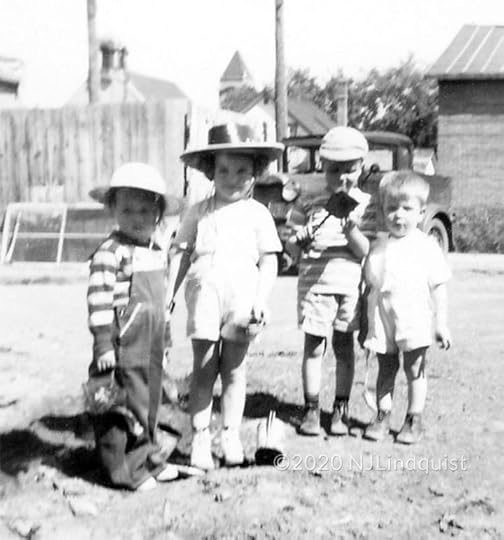
Me, age 3 1/2, in my red straw "cowboy" hat with (I believe) Donnie, Scott, and Greg
Since there wasn’t much shade in the backyard where I played, Mom decided I needed a hat to wear. We went to the small store in town that carried some kids' clothes, and I found a red straw cowboy hat. Mom thought it was a boy’s hat and got me a different one, but I continues to beg and plead, and in the end, my dad bought the red one for me. Mom continued to hate it, but I absolutely loved that hat. Now all I needed were the guns to go with it!
I Start to Make ComparisonsThat summer, I began to notice that not every mother was like mine. Well, at least the boys' mothers weren't. They didn't seem to care if the boys got dirty, and they didn't tell them to be careful all the time. I began to realize that in Mom’s mind, little girls didn’t do the things boys did. Little girls were supposed to be clean and tidy and well-behaved. I began to think boys had it better than girls. And I didn't see why there should be a difference.
Presumably, I could have just gone along with Mom and become a quiet, well-behaved little girl. But something in me resisted. I didn't think it was fair, and I wasn't going to meekly accept it. I wanted to be like the boys I played with who seemed to get away with a lot more, and who hardly ever got dressed up, and certainly didn't have to wear frilly dresses!
So Mom and I continued to battle. But because of where we were living at the time, she really didn't have much choice, so I kind of won. Mom had to get me some overalls and a few T-shirts and some shorts because dresses wouldn't have survived our back yard.
Playing OutdoorsOne wonderful thing that happened that spring is that Dad and Mom got me a tricycle. I loved that tricycle.
Yes, I liked to ride it. But it had other uses.
One of the boys had a small red wagon, so we'd get a parent to tie the wagon's handle to the back of the tricycle. Then, we could haul younger kids around the yard. Or, with the help of our pails and shovels, we could move dirt around.
If my dolls were present, they were getting rides in the wagon or lying on the dirt.
But even though Mom let me wear "boys clothes," she still had to keep them clean. And that was difficult because I didn't have a lot of clothes. Monday was washing day, but Mom continued to rinse a few of my things out by hand in the evenings. She began to despair of ever keeping my clothes or me clean.
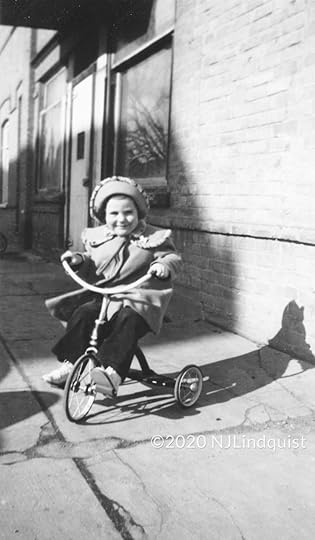
My first bike! This picture was taken in the spring in front of the building where we had an apartment above a business.
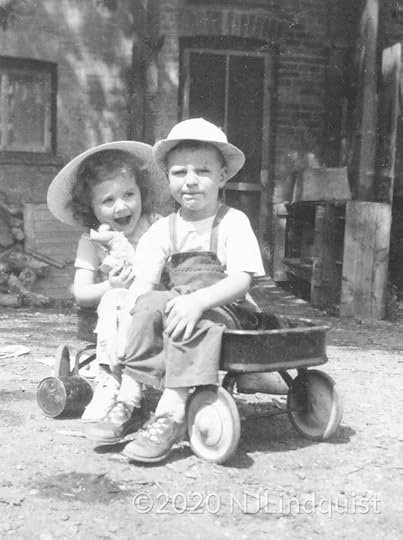
The hat Mom liked. Notice the doll has some clothes on, but is upside down. I think this was Donnie.
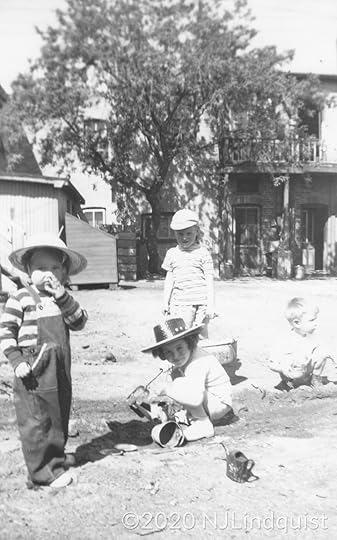
Digging in the dirt, and making mud, with the boys.
When I look back at our time in Wolseley, I can't help thinking how much I benefited from being able to play in the dirt with the boys. If I'd only had girls to play with, or if we'd lived in a house with a nice grass yard, I might have become a different person.
As it was, I had a great time, and in some intrinsic way, I learned that if I stood up for myself and didn't let Mom win all the time, I could find out who I was and who I wanted to be.
And yes, I still kind of like to play in dirt, although now I call it gardening (and I usually wear gloves).
. . . .
Can you relate?
If we hadn't moved to Wolseley and lived in that apartment, I might never have had a chance to find out I loved playing in the dirt.
Can you think of a time in your early years that might have altered who you are?
. . . .
LoveChild: Life Lessons from an Ugly Duckling is the story of my struggle to adjust to the life I was given, and my eventual discovery that, not only had I become a swan but, contrary to my perceptions, I had always been one. Though I didn't realize it until many years later, my life was part of a much bigger plan that all made perfect sense.
I'll be blogging my story once a week.
Find links to all these blogs at:
https://www.njlindquist.com/lovechild/
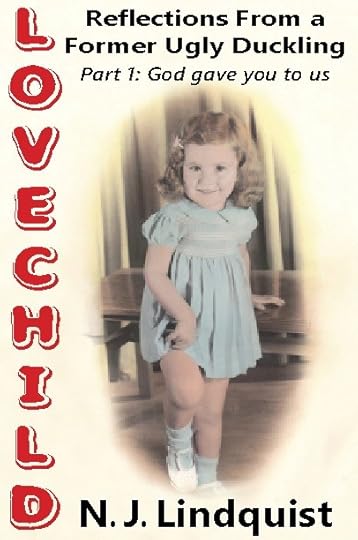
Have my new posts sent directly to your inbox.
Sign Up to Have All My New Posts Sent to Your Inbox
The post LoveChild 26: Sugar and Spice and Everything Nice appeared first on N. J. Lindquist.
February 5, 2020
LoveChild 25: My Hair Had a Mind of Its Own
“Those who have rebellious hair types understand the toxic relationship that you develop with it. You’ve learned love it over the years, but there are still times where you kind of wanted to pull it all out.”
When I was young, Mom and I battled incessantly over something I had absolutely no control over—my hair.
Everyone said my hair was lovely, but as it grew longer and thicker it began to get tangled.
This meant that when Mom brushed or combed my hair with my lovely nylon comb and brush set, my hair sometimes got pulled. And that hurt. So I cried, fought to get away, and yelled. As each month passed, my hair grew a little longer and my battles with Mom got worse.
Mom had very fine, straight hair, which was easily combed. She went regularly for perms to make it curl, but her hair was somewhat limp, so the best they could do was create waves and give it some "body."
Dad had straight hair which he kept quite short. It seemed to be quite well-behaved.
Neither of them had had any experience with hair like mine. And it never once occurred to either of them that combing and brushing my unruly hair the “normal” way might not be the best idea.
When I thought about it years later, I realized that Mom’s dad and two of her brothers had curly hair, but I guess since their hair was always kept short, it never became an issue. Or at least not one that involved Mom.
Mornings at our home became a battle. Then there was another battle after lunch when Mom changed me into a dress and got me ready to be seen in public and brushed my hair to make it look good.
Bath time was the worst!After I’d grown out of the small basin, Mom moved on to a galvanized steel wash tub like this one.
I normally had my bath on Saturday nights in the big wash tub Mom used for soaking laundry. Dad would put it on the kitchen floor where it was warm.
The picture shows me with a friend in a wash tub on a summer day. (Likely theirs because ours had no dent.) Our moms would let us get in the tub to cool off.
Believe it or not, I still have our wash tub. It's sitting on a shelf in our garage. We've used it for various things over the years.
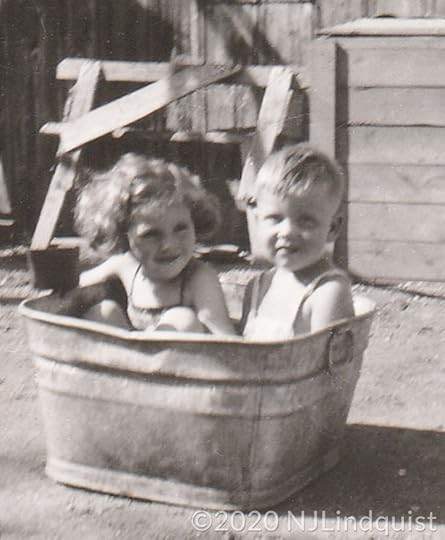
A wash tub served as a "paddling pool" on hot summer days.
Back to Saturday nights.First, Mom would give me a bath, which was okay. I liked to splash a bit and she would put a towel or blanket under the tub so the floor didn't get wet.
But soon it would be time to wash my hair before the water got cold.
Dad would pour warm water over my head to get it wet, and then Mom would add shampoo and scrub my hair and scalp to get it clean. Then Dad would pour more water over my head to rinse the soap out. And then one of them (usually Mom) would try to wring the water out of my hair like they would a pair of socks. Only then would they let me get out. Mom would wrap me in a towel while Dad rubbed my hair to get it dry. Seriously, it was as if having wet hair would doom me to get a cold or some other nasty thing.
I hated having my hair washed for several reasons.
First, the shampoo sometimes got in my eyes, and it stung. A lot! Then the water was sometimes a bit hot. What felt okay to Dad's hand sometimes felt too hot to me. So I'd cry or complain and he'd have to add cold water. But the worst part of the whole thing was when they tried to get the water out of my hair by wringing it. They always pulled my hair and made my scalp sore. So I’d basically cry and struggle for the entire time they were washing and drying my hair.
I actually think my scalp is extra-sensitive because I've had hairdressers who washed my hair and made my scalp hurt, and I never went back.
The good news is that I normally only had a bath on Saturday nights, so that kept our major battle down to once a week. Unless I got overly dirty during the week, of course.
First, Mom had to fight me to get hold of me so she could brush or comb my hair.
Then my hair would only stay put for a few minutes before it was all over the place again. It really was as if my hair had a mind of its own and barely waited until she was finished and then did whatever it wanted to do.
She did put barrettes in to try to hold it down. I remember there were pink ones and white ones and blue ones. But they didn't stay in very well because my hair was too thick. So they worked for a short time, but not for long.
No matter what she tried, Mom inevitably lost the battle to control my hair.
It was hardly my fault that my hair behaved the way it did, yet the bulk of the battle always ended up with Mom and me angry with each other.
Mom often ended up in tears herself, but she had no idea what to do. In her world, hair was meant to be brushed and combed, and she was determined to make my unruly hair behave.
So I learned to hate getting dressed up to go any place because that inevitably meant another battle with my hair.
Was this issue a nature vs nurture problem? My hair was clearly part of the package I'd been born with. But nurture was involved since Mom had no clue how to keep my hair from being a daily bone of contention.
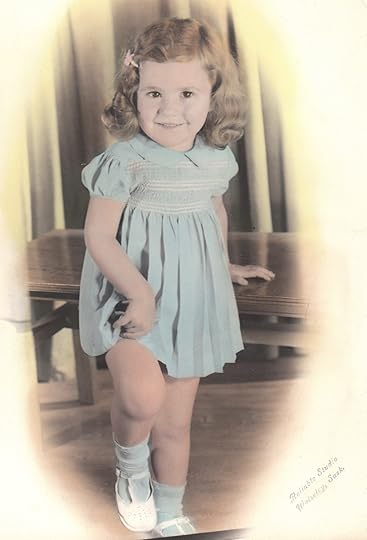
Me at 2 years, 10 months of age.
The problem finally came to a head a couple of months before I turned three. Trying to transform a tangle of frizzy curls into a smooth hairstyle simply became too much for Mom.
A few days after they had this formal picture taken of me when I was two years and ten months old, Mom convinced my dad to cut about five inches off my hair.
From that day until I turned twenty-one, my hair was kept short—sometimes really short!
Although it still had a mind of its own, and my scalp still hurt when my hair was washed each week, on a day-to-day basis, the shorter it was the less of a problem we had.
For anyone wondered about the colour of my hair, here it is. Yes, Mom kept some of my hair from my first haircut!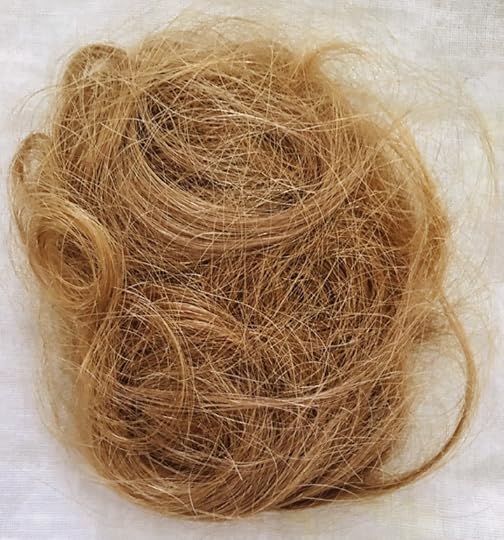
Some of the hair from my first hair cut.
Years later, after I finally let my hair grow long, Mom never ceased asking why I didn't cut it short because it looked so much better then. I sometimes argued, but mostly learned to ignore her comments because there was no point in making it an issue.
The truth? To this day, I hate having anyone else shampoo my hair, and I rarely go near hairdressers. Except for maybe a dozen times, I’ve cut my own hair since I was twenty-one.
And, sad to say, it wasn’t until I was fifty years old that I discovered why my hair was so badly behaved. (See my posts about my hair.)
Can you relate?
Was your hair a problem for you when you were young? Or was there something else about you that became a battleground with your mother or another member of your family?
How did it work out?
LoveChild: Life Lessons from an Ugly Duckling is the story of my struggle to adjust to the life I was given, and my eventual discovery that, not only had I become a swan but, contrary to my perceptions, I had always been one. Though I didn't realize it until many years later, my life was part of a much bigger plan that all made perfect sense.
I'll be blogging my story once a week.
Find links to all these blogs at:
https://www.njlindquist.com/lovechild/

Have my new posts sent directly to your inbox.
Sign Up to Have All My New Posts Sent to Your Inbox
The post LoveChild 25: My Hair Had a Mind of Its Own appeared first on N. J. Lindquist.
February 4, 2020
Putting the Heart Back into Valentine’s Day
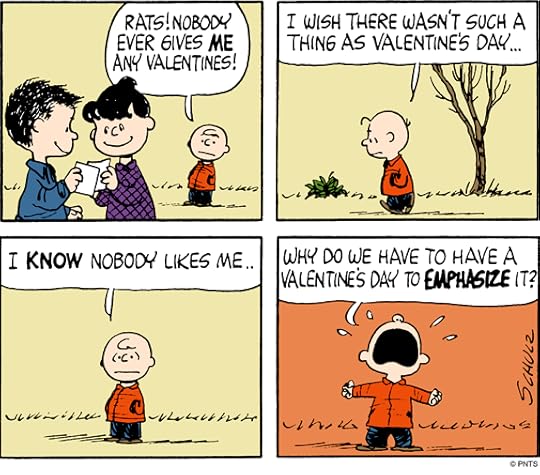
Cartoon from Peanuts Worldwide on Pinterest
Every time I think about Valentine’s Day, I remember the inevitable Charlie Brown cartoon with Charlie dreaming of all the Valentine’s cards he would get and then finding his mail box empty. I always sympathized.When I was in elementary school, we’d put our cards into a decorated box during the days before Valentine’s Day, and then the box was opened and the cards distributed to each person in the class. It was always agony for me. I was neither popular nor an outcast, but I was always afraid I wouldn’t get any cards, or I’d get a card from someone I hadn’t given one to, or vice versa.
I wanted to just stay home from school, but of course that wasn’t an option. And I couldn’t tell anyone how I felt because they’d likely think I was being silly. I mean, it was just paper cards!
Later, I homeschooled my kids. No, not because of Valentine’s Day, but when February came around, I was glad they/we didn’t have to deal with the whole cards thing. And my husband and I chose to downplay the day within our family. (Okay, we would usually buy some marshmallow chocolate hearts when they went on sale.)
But try as you might, you can’t ignore it.
Starting right after Christmas, every time you go into a store you’re bombarded by all the things you can buy for Valentine’s Day.
Photo by sarsmis from Deposit Photo.
It’s become like a competition to see who loves their partner or potential partner the most.
And, of course, you don’t really love your kids or grandkids if you don’t buy them a stuffed animal they don’t need and candy they also don’t need.
Since I grew unto adulthood, I’ve never felt obligated to buy things to show my love — especially things no one really needs. I mean, who decided that buying chocolates, stuffed animals, bouquets of flowers, jewellry and commercially produced cards are necessary to prove you love somebody?
Why not red apples in a heart-shaped box? Handwritten notes in a lunch box? A walk in the park? A hug? Clean dishes? A partner or parent who is always there for you?
I decided to check out the origins of Valentine’s Day.It turns out there are a number of different theories, ranging from February 14th being the day birds chose their mates, to old Roman festivals for chasing away wolves (?), to a priest who married young couples in spite of the emperor’s having forbidden marriage. (Rome was at war and the emperor thought bachelors fought better than married men.)
The story I like best is the one about an early Roman Christian named Valentine who was imprisoned because of his faith. Among his friends were many children who tossed notes of concern and love through the bars of his cell. Unfortunately, he was executed on February 14th. Later, this day was named St. Valentine’s Day after the martyr.
Cool. The thought of having a day to remind us to cheer up other people intrigued me.
Maybe Valentine’s day could be changed to a day when we do something nice for someone who needs cheering up?I was tempted to send a card to Charlie Brown, but no matter how much I’ve loved him through the years, he’s only a cartoon character.
I thought about who else I could send a Valentine to, and came up with a list.All the people who clean washrooms in public places. What would we do without you?All those who put their garbage into the right containers, put their shopping carts back where they belong, and in general try to care for the environment. You make a big difference.All those who cook balanced meals for other people who turn up their noses or grumble (like children and hospital patients). Whether we like it or not, the right food is very important to our health.All those who wait on other people in some way — cashiers, sales clerks, waitresses and waiters…. We may take you for granted, but we need you just the same.All those who work as doctors, nurses, therapists, aides, and orderlies, and are finding their jobs stressful from all the changes. Your patients may range from grumpy to clinging, but each one of them desperately needs to see your smiling face.All those who care for a loved one with Alzheimer’s or cerebral palsy or another life-impacting disease. Don’t ever think that what you are doing isn’t important.All those who have a child struggling with social, emotional, or intellectual problems. Don’t give up. Your encouragement and acceptance are vital.All those who are trying to be there for a friend or loved one with an emotional problem. You’re not alone even though it might feel that way.All those who are wondering what to do with the rest of their lives. Yeah, it can be hard to know. Keep trying different things until you find something you love.All those who are struggling financially or with their health. I know it’s hard.All those who have regrets. Fix what you can and have compassion on yourself when you can’t make amends.All those who are afraid. Being afraid can save you.All those who feel alone. You’re part of a vast crowd of people.Anyone reading this who needs a little bit of cheer.Consider this my Valentine for you.
Heart by sun-tiger from Deposit Photo. Meme by N. J. Lindquist.
Now I’m sure I’ve left someone out.So…maybe each one of us, either today or in the days to come, could do one practical thing for someone we know who might need a little cheering up.If we each did something, maybe no one would be left out. Well, except maybe Charlie Brown.
Of course, they do say giving is more fun than receiving…. I wonder if Charlie ever discovered that?
Original version published in my “That’s Life” column in the Markham Economist-Sun, Feb. 14, 1998.
The post Putting the Heart Back into Valentine’s Day appeared first on N. J. Lindquist.
January 29, 2020
LoveChild 24: Mom Was Trying to Be a Good Mother
“There was a little girl who had a little curl, right in the middle of her forehead. And when she was good, she was very, very good. But when she was bad, she was horrid.”
Henry Wadsworth Longfellow
By the time I was two and a half, my mother was worried
As I mentioned in my earlier post "Growing Pains," my mother loved having a baby she could care for and enjoy, but she hadn't anticipated having a toddler who ignored instructions to keep her clothes clean and was constantly getting into things she wasn't supposed to. By the time I was two and a half, and could run away, our difficulties were compounded.
I don't blame Mom. She'd left home at sixteen, and even though she'd had six younger siblings, hadn't been old enough to help with her next three brothers because they weren't all that much younger than her. And the next sibling had been born when Mom was eighteen and had been away from home for two years.
In Winnipeg, she'd lived with older adults and worked at Eaton's, and I assume she didn't have a lot of close friends who had children. Even after marrying Dad, she'd only have had contact with a few people who had young children. Even his younger sister Jean and brother-in-law Howard had kids who were eight and ten by the time I came into their lives.
In Indian Head, most of their friends had children who were well past the toddler age.
And Mom was likely reluctant to ask for help. She was very sensitive about what people thought (or what she thought they thought) and she'd have wanted people to think all was well.
I wasn’t all that fond of playing nicely with my dolls, which were almost the only toys I had. I’m not sure what Mom thought I should do with them, but as you can see by the pictures in this and previous posts, I tended to take their clothes off, carry them around by their hair, and generally not treat them the way she thought was proper.
Which brings me to another point.
According to Mom I “had a mind of my own” and rarely obeyed her the first time. Which, naturally, frustrated her no end. Plus, instead of doing what I was told, I was constantly asking, “Why?”
One of the nursery rhymes in a book I had, which my mother said was written for me, was Henry Wadsworth Longfellow’s poem, which I put at the top here. I knew Mom thought I was exactly like the little girl in that poem.
What strikes me today is the idea that I shouldn't have had a "mind of my own." Of course, I did. All children do. And that's what gets many of us/them into trouble.
On the one hand, Mom was thrilled that I was to all intent and purposes a healthy, intelligent child. But at the same time, she found me exasperating. I could be totally happy and charming one minute and driving her crazy the next.
Plus, I'm sure that anyone who saw me would have assumed I was a lovely child. I mean, look at me! A little Shirley Temple, right?
Okay, looks can be deceiving. Yes, I had mastered the angelic look. But inside, I was a very stubborn little girl.
So my poor mom struggled along, afraid that she wasn't a very good mother because I wasn't a very obedient child.
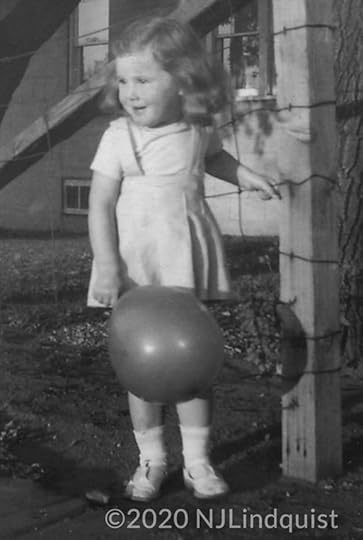 Curiosity Killed the Cat
Curiosity Killed the CatMy mother had a lot of sayings she'd picked up over the years as well as some superstitions she really thought would be harmful. For example, putting a hat on a bed with a no-no, as was picking up your own glove if you dropped it.
If I heard the adage about curiosity killing the cat once when I was young, I heard it a thousand times. (The hat and glove superstitions, too.)
But I was born curious.
Looking back, I can see how disconcerting it was for her to have to deal with a small child who was constantly asking questions and had very strong opinions about pretty well everything and everyone, even at the age of two.
But the biggest problem was that our opinions frequently clashed. Things and people she liked, I didn’t, and vice versa. The truth is, I was nothing like the daughter Mom had pictured in her mind. Understandably, she'd wanted/hoped for a daughter who would be interested in the same things as her, and even as a very little girl, I just wasn't.
We Have Historical EvidenceI assume Dad was with us that day as well, because someone other than Mom took the last picture.
Anyway, in the pictures below, I was two and a half, and my parents and I were enjoying an afternoon at Fairly Park in Wolseley. I have my doll, and maybe a flower I've picked...? I look so sweet. (Hmm. I think I know where several of my grandkids got this look.)
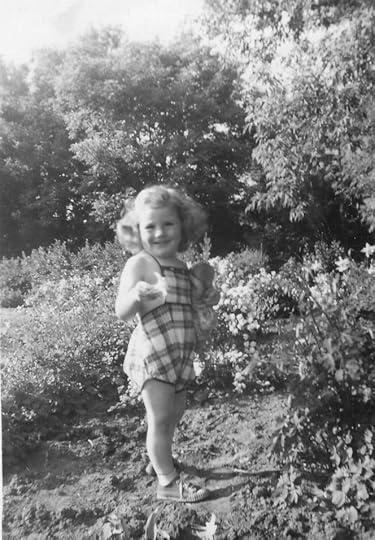
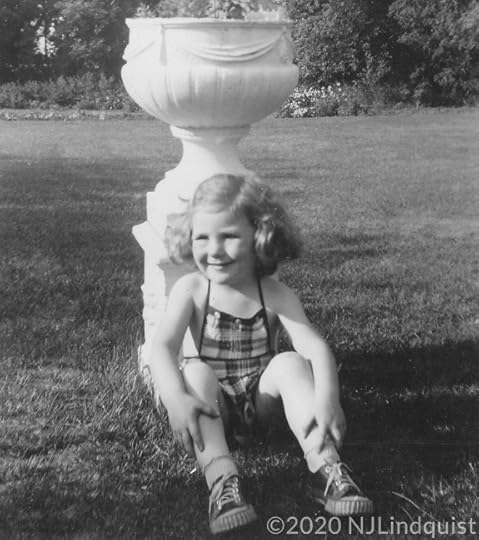
A few minutes after the above pictures were taken, Mom told me not to take my doll’s clothes off.
As you can see in the picture to the right, I immediately became very angry, which is why I was shaking my doll and threatening to throw her into the water.
According to Mom, right after she took this picture, I did throw my doll into the water.
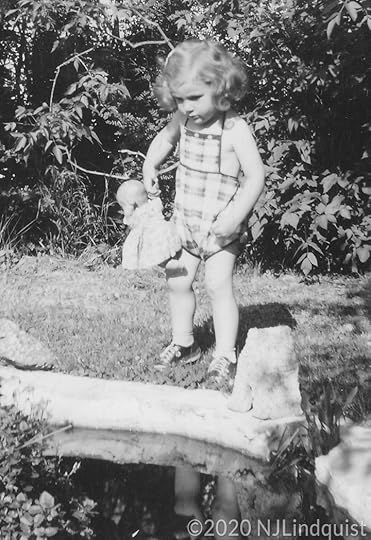
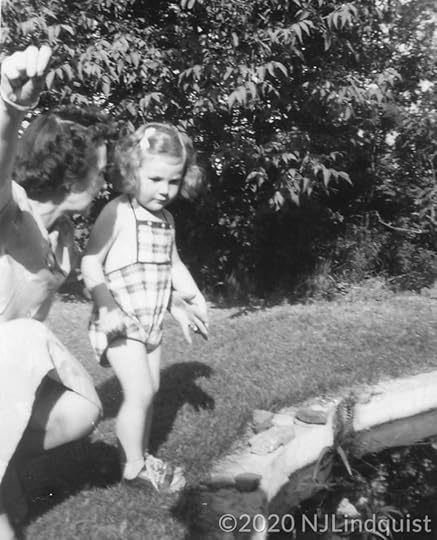
This picture is Mom explaining to me why I shouldn't have thrown my doll in the water and expressing her displeasure with me.
(I expect my dad took the picture because he had a tendency to cut off parts of people in most of the pictures he took.)
Anyone, you can see from Mom's body language that she's not very happy at all, and you can see from mine that I'm not all that concerned. I was probably trying to figure out how to get my doll out of the water without getting wet.
The ShowdownBack then, spanking was something parents did when children misbehaved. Dad often referred to his dad’s having taken him out behind the barn. Everyone knew what that meant.
Mom did her best to make me behave, but now and then she would spank me or tell me to “Just wait until your dad gets home!” And Dad did spank me a few times, but I knew he really didn’t want to and was only doing it because Mom expected him to.
I didn’t mind so much when I knew I’d disobeyed. The problem with Mom was that I was never 100% sure what would make her angry. Things that seemed minor to me were sometimes major to her.
I knew Mom was often unhappy with me, and that I was frequently a bad girl, but I really didn’t know how to be the obedient, well-behaved daughter she wanted. I was too curious to go long without trying to understand new things and learn as much as I could. I wanted to understand why and not simply accept what I was told.
But far too often, when I spoke, we ended up yelling at each other.
The last time I remember Mom’s spanking me was probably the fall when I was three and a half. I don’t remember what I’d done that day to make her angry, but she really lost her temper.
I do know that my dad's mom, Jennie Shaw, (Mom and I called her Granny Shaw) was visiting us at the time, and she was up in our apartment. Mom and I were outside, and Mom grabbed a small branch from what was likely a caragana bush—what was called a switch—and used it to strike me. She was likely aiming at my seat, but she hit me on my bare legs.
It stung terribly and I ran toward the door where the stairs led up to our apartment. I was screaming, “I’m sorry! I won’t do it again!”
Mom was screaming for me to stop running, and calling, “Just wait until I catch you!”
I ran upstairs and hid in my room, sobbing and hiccupping, terrified that she was going to really hurt me this time.
Out in the hallway, I heard Granny Shaw say to Mom in a calm, but determined voice, “Margaret, I don’t like to interfere. But you must never allow yourself to become so angry with a child.” After that, their voices grew quieter. I could hear them talking, but not make out what they were saying.
Mom didn’t come into my room for a long time, and when she did, it was to say she was sorry for using the switch. She looked at the red welts on the backs of my legs, and she cried, and so did I.
That’s the last time she ever struck me with anything other than her hand, although I know she was sorely tried.
Years later, Mom talked to me about that day and how exasperating I was, and what Granny Shaw had said to her about letting her anger overrule her good sense, and that one must never strike a child in anger. Mom was, of course, terribly embarrassed that Granny Shaw had seen her lose control, but she was also glad that she'd been visiting at the time and could help her see that she couldn’t let my disobeying her cause her to do something she’d later regret.
She wasn’t nearly as glad as I was.
Thinking It OverLong before I reached the age of four, I’d realized that I needed to keep many of my questions and thoughts to myself. I expect that’s probably normal. A child separates from the parent when you start thinking different thoughts. When you want to have one more story, and your dad or mom says, “No, you need to go to sleep.” When you decide you don’t want to eat your dinner and you’re told you have to eat it or else. When you go to touch that shiny ornament and a hand stops you in your tracks and says, “No. Don’t touch that—you could break it.” At some point, you have to decide whether to voice your opinion at every opportunity or keep silent now and then.
The popular old adage “Children should be seen and not heard” implies that over the years, most children have been encouraged to keep their thoughts to themselves.
For me, it was simply realizing that when I stated a contrary opinion or asked a leading question, it usually led to Mom’s getting mad at me. Whereas if I didn’t voice my thoughts, the worst thing that happened was that Mom complained that I was too quiet.
In the end, I think our scary confrontation made me realize that Mom could be pushed too far, and I was smart enough to realize that even when I was convinced I was right and she was wrong, not saying anything was better than arguing. And most of the time it was wiser to go along with what Mom wanted me to do rather than to ignore or defy her.
So, while I continued to pester Mom with questions and wasn't always the perfect child in private, I did learn not to argue with her or be nosey, but rather to sit quietly with my dolls or books when we had company or were visiting other people so Mom didn’t get stressed.
Of course, there were some things I didn't have control over, like my unruly hair.
. . .
Can You Relate?
Can you remember when you were very young and just learning that you had a mind of your own?" How did your parents or other family members respond?
@media (min-width: 300px){.thrv_symbol_10531 [data-css="tve-u-1656479a734"] { width: 100px; float: none; border: 1px solid rgb(0, 0, 0); box-shadow: rgba(0, 0, 0, 0.4) 0px 8px 12px 0px; margin-left: auto !important; margin-right: auto !important; margin-top: 0px !important; }.thrv_symbol_10531 [data-css="tve-u-1656479a731"] { margin-left: 9px !important; }.thrv_symbol_10531 [data-css="tve-u-1656479a730"] { max-width: 57.4%; }.thrv_symbol_10531 [data-css="tve-u-1656479a733"] { max-width: 42.6%; }.thrv_symbol_10531 [data-css="tve-u-1656479a72f"] { max-width: 820px; float: none; width: 100%; margin-left: auto !important; margin-right: auto !important; }.thrv_symbol_10531 [data-css="tve-u-1656479a72e"] { min-height: 245px; }:not(#tve) .thrv_symbol_10531 [data-css="tve-u-1656479a734"] { width: 252px; }:not(#tve) .thrv_symbol_10531 [data-css="tve-u-1656d159d04"] { font-size: 18px !important; }:not(#tve) .thrv_symbol_10531 [data-css="tve-u-1656d159d06"] { font-size: 18px !important; }:not(#tve) .thrv_symbol_10531 [data-css="tve-u-1656d15d51d"] { max-width: 679px; float: none; width: 100%; margin-left: auto !important; margin-right: auto !important; }:not(#tve) .thrv_symbol_10531 [data-css="tve-u-1656d15d51d"] > .tve-cb { justify-content: center; display: flex; flex-direction: column; }:not(#tve) .thrv_symbol_10531 [data-css="tve-u-1656d16fbe9"] { float: none; width: 100%; margin-left: auto !important; margin-right: auto !important; }:not(#tve) .thrv_symbol_10531 [data-css="tve-u-1656d1795e1"] { font-size: 18px !important; line-height: 0.35em !important; }:not(#tve) .thrv_symbol_10531 [data-css="tve-u-1656d17bf7c"] { line-height: 0.6em !important; color: rgb(113, 30, 30) !important; }}
. . .
LoveChild: Life Lessons from an Ugly Duckling is the story of my struggle to adjust to the life I was given, and my eventual discovery that, not only had I become a swan but, contrary to my perceptions, I had always been one. Though I didn't realize it until many years later, my life was part of a much bigger plan that all made perfect sense.
I'll be blogging my story once a week.
Find links to all these blogs at:
https://www.njlindquist.com/lovechild/
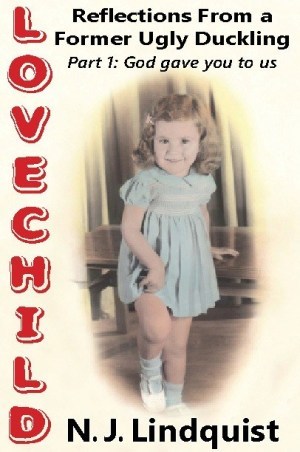
@media (min-width: 300px){.thrv_symbol_10677 [data-css="tve-u-170839f7c3e"] { max-width: 515px; float: none; border: 2px solid rgb(0, 0, 0); margin: 40px auto !important; padding-left: 40px !important; padding-right: 40px !important; }:not(#tve) .thrv_symbol_10677 [data-css="tve-u-170839f7c40"] button { background-image: none !important; background-color: rgb(113, 30, 30) !important; }}
Sign Up to Have My New Memoir Posts Sent Directly to Your Inbox
The post LoveChild 24: Mom Was Trying to Be a Good Mother appeared first on N. J. Lindquist.
LoveChild 24: Mom Was Trying to Be a Good Mother, But I Wasn’t Exactly a Model Child
“There was a little girl who had a little curl, right in the middle of her forehead. And when she was good, she was very, very good. But when she was bad, she was horrid.”
Henry Wadsworth Longfellow
By the time I was two and a half, my mother was worried
As I mentioned in my earlier post "Growing Pains," my mother loved having a baby she could care for and enjoy, but she hadn't anticipated having a toddler who ignored instructions to keep her clothes clean and was constantly getting into things she wasn't supposed to. By the time I was two and a half, and could run away, our difficulties were compounded.
I don't blame Mom. She'd left home at sixteen, and even though she'd had six younger siblings, hadn't been old enough to help with her next three brothers because they weren't all that much younger than her. And the next sibling had been born when Mom was eighteen and had been away from home for two years.
In Winnipeg, she'd lived with older adults and worked at Eaton's, and I assume she didn't have a lot of close friends who had children. Even after marrying Dad, she'd only have had contact with a few people who had young children. Even his younger sister Jean and brother-in-law Howard had kids who were eight and ten by the time I came into their lives.
In Indian Head, most of their friends had children who were well past the toddler age.
And Mom was likely reluctant to ask for help. She was very sensitive about what people thought (or what she thought they thought) and she'd have wanted people to think all was well.
I wasn’t all that fond of playing nicely with my dolls, which were almost the only toys I had. I’m not sure what Mom thought I should do with them, but as you can see by the pictures in this and previous posts, I tended to take their clothes off, carry them around by their hair, and generally not treat them the way she thought was proper.
Which brings me to another point.
According to Mom I “had a mind of my own” and rarely obeyed her the first time. Which, naturally, frustrated her no end. Plus, instead of doing what I was told, I was constantly asking, “Why?”
One of the nursery rhymes in a book I had, which my mother said was written for me, was Henry Wadsworth Longfellow’s poem, which I put at the top here. I knew Mom thought I was exactly like the little girl in that poem.
What strikes me today is the idea that I shouldn't have had a "mind of my own." Of course, I did. All children do. And that's what gets many of us/them into trouble.
On the one hand, Mom was thrilled that I was to all intent and purposes a healthy, intelligent child. But at the same time, she found me exasperating. I could be totally happy and charming one minute and driving her crazy the next.
Plus, I'm sure that anyone who saw me would have assumed I was a lovely child. I mean, look at me! A little Shirley Temple, right?
Okay, looks can be deceiving. Yes, I had mastered the angelic look. But inside, I was a very stubborn little girl.
So my poor mom struggled along, afraid that she wasn't a very good mother because I wasn't a very obedient child.
 Curiosity Killed the Cat
Curiosity Killed the CatMy mother had a lot of sayings she'd picked up over the years as well as some superstitions she really thought would be harmful. For example, putting a hat on a bed with a no-no, as was picking up your own glove if you dropped it.
If I heard the adage about curiosity killing the cat once when I was young, I heard it a thousand times. (The hat and glove superstitions, too.)
But I was born curious.
Looking back, I can see how disconcerting it was for her to have to deal with a small child who was constantly asking questions and had very strong opinions about pretty well everything and everyone, even at the age of two.
But the biggest problem was that our opinions frequently clashed. Things and people she liked, I didn’t, and vice versa. The truth is, I was nothing like the daughter Mom had pictured in her mind. Understandably, she'd wanted/hoped for a daughter who would be interested in the same things as her, and even as a very little girl, I just wasn't.
We Have Historical EvidenceI assume Dad was with us that day as well, because someone other than Mom took the last picture.
Anyway, in the pictures below, I was two and a half, and my parents and I were enjoying an afternoon at Fairly Park in Wolseley. I have my doll, and maybe a flower I've picked...? I look so sweet. (Hmm. I think I know where several of my grandkids got this look.)


A few minutes after the above pictures were taken, Mom told me not to take my doll’s clothes off.
As you can see in the picture to the right, I immediately became very angry, which is why I was shaking my doll and threatening to throw her into the water.
According to Mom, right after she took this picture, I did throw my doll into the water.


This picture is Mom explaining to me why I shouldn't have thrown my doll in the water and expressing her displeasure with me.
(I expect my dad took the picture because he had a tendency to cut off parts of people in most of the pictures he took.)
Anyone, you can see from Mom's body language that she's not very happy at all, and you can see from mine that I'm not all that concerned. I was probably trying to figure out how to get my doll out of the water without getting wet.
The ShowdownBack then, spanking was something parents did when children misbehaved. Dad often referred to his dad’s having taken him out behind the barn. Everyone knew what that meant.
Mom did her best to make me behave, but now and then she would spank me or tell me to “Just wait until your dad gets home!” And Dad did spank me a few times, but I knew he really didn’t want to and was only doing it because Mom expected him to.
I didn’t mind so much when I knew I’d disobeyed. The problem with Mom was that I was never 100% sure what would make her angry. Things that seemed minor to me were sometimes major to her.
I knew Mom was often unhappy with me, and that I was frequently a bad girl, but I really didn’t know how to be the obedient, well-behaved daughter she wanted. I was too curious to go long without trying to understand new things and learn as much as I could. I wanted to understand why and not simply accept what I was told.
But far too often, when I spoke, we ended up yelling at each other.
The last time I remember Mom’s spanking me was probably the fall when I was three and a half. I don’t remember what I’d done that day to make her angry, but she really lost her temper.
I do know that my dad's mom, Jennie Shaw, (Mom and I called her Granny Shaw) was visiting us at the time, and she was up in our apartment. Mom and I were outside, and Mom grabbed a small branch from what was likely a caragana bush—what was called a switch—and used it to strike me. She was likely aiming at my seat, but she hit me on my bare legs.
It stung terribly and I ran toward the door where the stairs led up to our apartment. I was screaming, “I’m sorry! I won’t do it again!”
Mom was screaming for me to stop running, and calling, “Just wait until I catch you!”
I ran upstairs and hid in my room, sobbing and hiccuping, terrified that she was going to really hurt me this time.
Out in the hallway, I heard Granny Shaw say to Mom in a calm, but determined voice, “Margaret, I don’t like to interfere. But you must never allow yourself to become so angry with a child.” After that, their voices grew quieter. I could hear them talking, but not make out what they were saying.
Mom didn’t come into my room for a long time, and when she did, it was to say she was sorry for using the switch. She looked at the red welts on the backs of my legs, and she cried, and so did I.
That’s the last time she ever struck me with anything other than her hand, although I know she was sorely tried.
Years later, Mom talked to me about that day and how exasperating I was, and what Granny Shaw had said to her about letting her anger overrule her good sense, and that one must never strike a child in anger. Mom was, of course, terribly embarrassed that Granny Shaw had seen her lose control, but she was also glad that she'd been visiting at the time and could help her see that she couldn’t let my disobeying her cause her to do something she’d later regret.
She wasn’t nearly as glad as I was.
Thinking It OverLong before I reached the age of four, I’d realized that I needed to keep many of my questions and thoughts to myself. I expect that’s probably normal. A child separates from the parent when you start thinking different thoughts. When you want to have one more story, and your dad or mom says, “No, you need to go to sleep.” When you decide you don’t want to eat your dinner and you’re told you have to eat it or else. When you go to touch that shiny ornament and a hand stops you in your tracks and says, “No. Don’t touch that—you could break it.” At some point, you have to decide whether to voice your opinion at every opportunity or keep silent now and then.
The popular old adage “Children should be seen and not heard” implies that over the years, most children have been encouraged to keep their thoughts to themselves.
For me, it was simply realizing that when I stated a contrary opinion or asked a leading question, it usually led to Mom’s getting mad at me. Whereas if I didn’t voice my thoughts, the worst thing that happened was that Mom complained that I was too quiet.
In the end, I think our scary confrontation made me realize that Mom could be pushed too far, and I was smart enough to realize that even when I was convinced I was right and she was wrong, not saying anything was better than arguing. And most of the time it was wiser to go along with what Mom wanted me to do rather than to ignore or defy her.
So, while I continued to pester Mom with questions and wasn't always the perfect child in private, I did learn not to argue with her or be nosey, but rather to sit quietly with my dolls or books when we had company or were visiting other people so Mom didn’t get stressed.
Of course, there were some things I didn't have control over, like my unruly hair.
Can You Relate?
Can you remember when you were very young and just learning that you had a mind of your own?" How did your parents or other family members respond?
@media (min-width: 300px){.thrv_symbol_10531 [data-css="tve-u-1656479a734"] { width: 100px; float: none; border: 1px solid rgb(0, 0, 0); box-shadow: rgba(0, 0, 0, 0.4) 0px 8px 12px 0px; margin-left: auto !important; margin-right: auto !important; margin-top: 0px !important; }.thrv_symbol_10531 [data-css="tve-u-1656479a731"] { margin-left: 9px !important; }.thrv_symbol_10531 [data-css="tve-u-1656479a730"] { max-width: 57.4%; }.thrv_symbol_10531 [data-css="tve-u-1656479a733"] { max-width: 42.6%; }.thrv_symbol_10531 [data-css="tve-u-1656479a72f"] { max-width: 820px; float: none; width: 100%; margin-left: auto !important; margin-right: auto !important; }.thrv_symbol_10531 [data-css="tve-u-1656479a72e"] { min-height: 245px; }:not(#tve) .thrv_symbol_10531 [data-css="tve-u-1656479a734"] { width: 252px; }:not(#tve) .thrv_symbol_10531 [data-css="tve-u-1656d159d04"] { font-size: 18px !important; }:not(#tve) .thrv_symbol_10531 [data-css="tve-u-1656d159d06"] { font-size: 18px !important; }:not(#tve) .thrv_symbol_10531 [data-css="tve-u-1656d15d51d"] { max-width: 679px; float: none; width: 100%; margin-left: auto !important; margin-right: auto !important; }:not(#tve) .thrv_symbol_10531 [data-css="tve-u-1656d15d51d"] > .tve-cb { justify-content: center; display: flex; flex-direction: column; }:not(#tve) .thrv_symbol_10531 [data-css="tve-u-1656d16fbe9"] { float: none; width: 100%; margin-left: auto !important; margin-right: auto !important; }:not(#tve) .thrv_symbol_10531 [data-css="tve-u-1656d1795e1"] { font-size: 18px !important; line-height: 0.35em !important; }:not(#tve) .thrv_symbol_10531 [data-css="tve-u-1656d17bf7c"] { line-height: 0.6em !important; color: rgb(113, 30, 30) !important; }}
. . .
LoveChild: Life Lessons from an Ugly Duckling is the story of my struggle to adjust to the life I was given, and my eventual discovery that, not only had I become a swan but, contrary to my perceptions, I had always been one. Though I didn't realize it until many years later, my life was part of a much bigger plan that all made perfect sense.
I'll be blogging my story once a week.
Find links to all these blogs at:
https://www.njlindquist.com/lovechild/

@media (min-width: 300px){.thrv_symbol_10531 [data-css="tve-u-1656479a734"] { width: 277px; float: none; margin-left: auto !important; margin-right: auto !important; margin-top: 0px !important; }.thrv_symbol_10531 [data-css="tve-u-1656479a731"] { margin-left: 9px !important; }.thrv_symbol_10531 [data-css="tve-u-1656479a730"] { max-width: 57.4%; }.thrv_symbol_10531 [data-css="tve-u-1656479a733"] { max-width: 42.6%; }.thrv_symbol_10531 [data-css="tve-u-1656479a72f"] { max-width: 820px; float: none; width: 100%; margin-left: auto !important; margin-right: auto !important; }.thrv_symbol_10531 [data-css="tve-u-1656479a72e"] { min-height: 245px; }:not(#tve) .thrv_symbol_10677 [data-css="tve-u-1656479a734"] { width: 252px; }:not(#tve) .thrv_symbol_10677 [data-css="tve-u-1656d159d04"] { font-size: 18px !important; }:not(#tve) .thrv_symbol_10677 [data-css="tve-u-1656d159d06"] { font-size: 18px !important; }:not(#tve) .thrv_symbol_10677 [data-css="tve-u-1656d15d51d"] { max-width: 679px; float: none; width: 100%; margin-left: auto !important; margin-right: auto !important; }:not(#tve) .thrv_symbol_10677 [data-css="tve-u-1656d15d51d"] > .tve-cb { justify-content: center; display: flex; flex-direction: column; }:not(#tve) .thrv_symbol_10677 [data-css="tve-u-1656d16fbe9"] { float: none; width: 100%; margin-left: auto !important; margin-right: auto !important; }:not(#tve) .thrv_symbol_10677 [data-css="tve-u-1656d1795e1"] { font-size: 18px !important; line-height: 0.35em !important; }:not(#tve) .thrv_symbol_10677 [data-css="tve-u-1656d17bf7c"] { line-height: 0.6em !important; color: rgb(113, 30, 30) !important; }:not(#tve) .thrv_symbol_10677 [data-css="tve-u-165876ba63a"] button { background-image: none !important; background-color: rgb(113, 30, 30) !important; }.thrv_symbol_10677 [data-css="tve-u-165876ba639"] { max-width: 515px; float: none; margin-left: auto !important; margin-right: auto !important; }:not(#tve) .thrv_symbol_10677 [data-css="tve-u-16587b55abb"] { font-size: 22px !important; }}
Have my new posts sent directly to your inbox.
Sign Up to Have All My New Posts Sent to Your Inbox
The post LoveChild 24: Mom Was Trying to Be a Good Mother, But I Wasn’t Exactly a Model Child appeared first on N. J. Lindquist.
January 22, 2020
LoveChild 23: Our New Life in Wolseley
“I give you this to take with you: Nothing remains as it was. If you know this, you can begin again, with pure joy in the uprooting.”
Judith Minty, Letters to My Daughters
I turned two years old in our new home in Wolseley.
Mom wrote in my Baby Book that my second birthday was celebrated quietly, with cake and ice cream.
Just Nancy, Daddy, Mama, & Bozo.
Nylon brush from Daddy & Mama
Silver knife and fork and spoon from Granny Shaw
A book from Mrs. McDougall
A card from Hazel Hamblin at Indian Head
The picture of me taken closest to my second birthday has all but my eyes covered by the snowsuit I showed you in the last post. The next closest picture is this one, which was taken in the spring of 1950 on the steps of the Town Hall, which seems to have been one of my parents' favourite places for pictures.
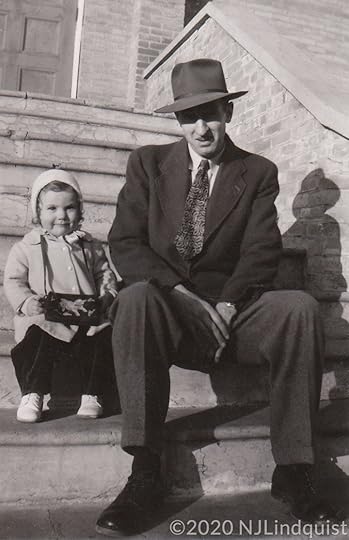
Our Life is Quite Different
Mom and Dad had been living in Indian Head for eleven years, and had made a number of friends there. But they had few, if any, friends in Wolseley.
The town itself consisted of a row of stores along the railroad tracks, an intersecting street that went at a 90 degree angle away from the tracks. The intersecting street was very wide and had more stores on both sides with apartments above many of them. There were houses going off in three directions behind the stores, some of them circling Fairly Lake, a small lake which was more or less in the middle of the town. The Town Hall and churches were a little distance from downtown as well.
In Indian Head, we'd had a small bungalow with a yard on a street with other houses. In Wolseley, we were living in one of several apartments over a brick two-story building that had a row of small stores on ground level. This was on the street that angled away from the railway tracks. Based on several pictures taken of me in front of buildings on the sttreet when we lived there, it might even have been the building shown here, that now has a Medical Clinic. http://wolseley.ca/wp-content/uploads/Userfile/dsc01686.jpg
It's possible that the store below our apartment was one Dad had bought or leased, and was a men's clothing store, but I only have a brief line in my Uncle Jim's letter, which I'll show you soon, to make me think that.
In any case, Dad was working hard with both a store to run and the mink farm to help look after, so we didn't see much of him. He was very focused on making a go of both so that he had enough money for a decent life for all three of us.
I have no idea what his actual involvement with the mink was. I don't think I was ever told or wanted to know. I assume they had to be fed and their cages cleaned, and so forth. Maybe his partner did that, or maybe they took turns. Anyway, I have no memory of his being dressed to clean cages. Unless he was on holidays, I only ever remember him dressed in either a suit or a good shirt and pants, a tie, and a sports jacket.
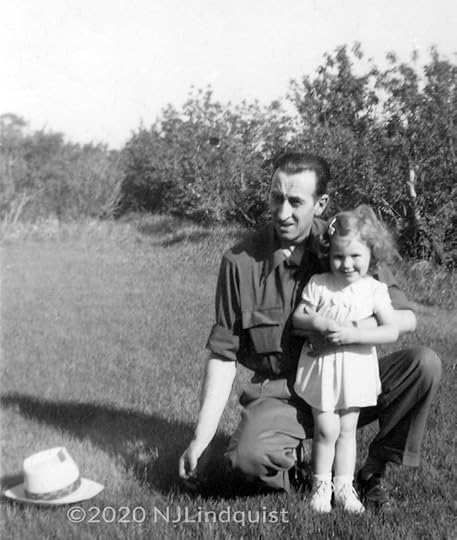
On the grounds around Fairly Lake.
As was the case in Indian Head, much of Mom’s, and therefore my life in Wolseley revolved around cooking meals, washing dishes, making beds, dusting, sweeping the floors, washing and ironing clothes, getting groceries and doing other shopping, and so forth. Oh, and doing that without spending any more money than was absolutely essential.
Since we were in a small apartment, Bozo and Fluffy would have been a little more constrained than before. But, back then, dogs and cats roamed freely, so I guess it was just a matter of letting them outside whenever they wanted to go and calling them when you wanted them inside.
As in Indian Head, I was usually in bed not long after seven, so I’d see Dad for only a little while after he got home from work. After supper, he’d spend a few minutes reading my books, and, as I got older, playing a simple game like catch with a rubber ball. He'd also listen to me as I told him what my dolls and I had been doing.
After I was in bed, Mom and Dad would read any newspapers or magazines they had access to, and listen to programs on the radio. On Friday or Saturday evening, they might visit friends or have friends over. I assume they made some friends with other people who were living in apartments over stores, and they found a lady who would come and babysit me on the occasional times when they went out together.
On Sundays, we went to church in the morning and then we might go for a drive in the afternoon. We were dependent on Dad to take us anywhere, and Mom loved getting out and just driving around the town or the countryside. Of course, this was long before seat belts or car seats, so I'd be in the back seat playing with my dolls.
Sometimes we drove to Indian Head to visit friends there.
I loved our new church!
I assume we were going to the church before this, but on Monday, May 1, 1950, I was formally enrolled into the Baby Band of St. James United Church in Wolseley.
Two days later, on May 3, 1950, I was enrolled in the church's Cradle Roll.
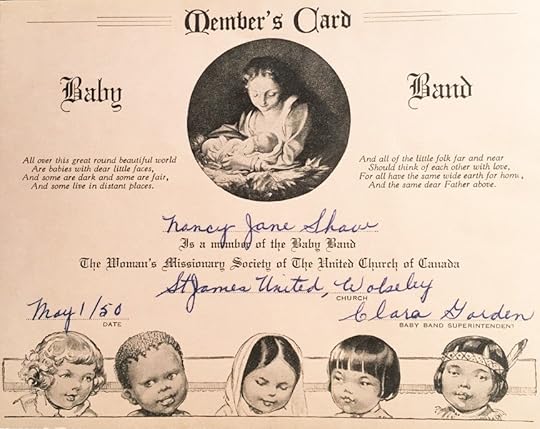
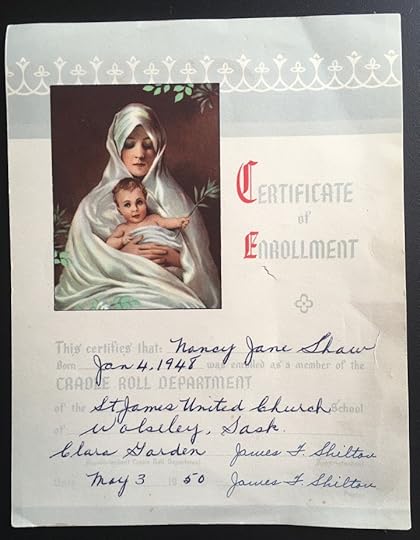
By then, I was nearly two years and four months old and eager to learn! I can actually remember the excitement I felt as we went down the stairs to the church basement each week. I felt warm and happy to be there. Not in the least concerned about being left by my parents.
I was excited to be learning new things. I loved the songs and the crafts we did, but mostly I loved hearing the Bible stories. At home, I had only a few books, which my parents read over and over to me. Here, there was a new story every single time I went! And there were toys to play with! And we did crafts and played games, too. I loved going to Baby Band!
Visits with Family
Because money was so tight, and neither of their families had much money either, Mom and Dad rarely got to see their families back in Manitoba.
But we did make one visit to Brandon during the summer of 1950 for what I believe was my grandmother, Jennie Shaw's, 75th birthday.
Yes, Mom is holding me there because I wanted to be elsewhere.
Note that my doll actually has clothes on.
Also, one of the rare photos of my dad with a T-shirt on. But he still wore dress pants.
Mom usually wore a dress, and she loved high heels of any kind.
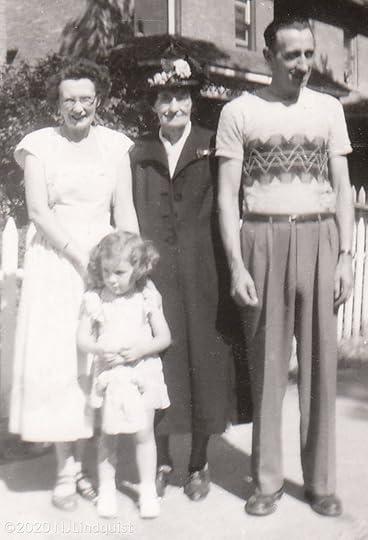
Mom (Margaret Shaw), me, Granny (Jennie) Shaw, Dad (Bob Shaw)
A New Challenge
I have no idea if Mom saw the irony in this picture or not.
I was two and a half years old and ready to go to church (and quite happy about it as you can see).
I’m in a large back alley sitting on a log near a pile of firewood, and I'm wearing a very pale dress with white socks and shoes.
A boy who lived in an apartment like ours is dressed only in what looks like a diaper, and is barefoot. There's another boy as well, sitting on the dirt.
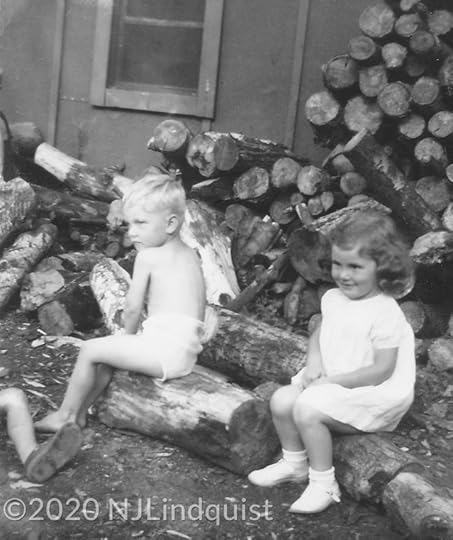
This was part of the yard behind the apartments, and this was where the kids from the apartments played.
You can imagine how much my mother hated that yard.
. . . . . . . . . . . . . . . . . . . . . . . . . . . . .
Can You Relate?
My parents "started over" a number of times.
Have you ever upended your life? Left one job for another in the hope that the new one would be more fulfilling or financially better? Left your home and started over in a new place? Done both at the same time?
Does the thought of moving to a new place excite you or frighten you?
. . . . . . . . . . . . . . . . . . . . . . . . . . . . .
@media (min-width: 300px){.thrv_symbol_10531 [data-css="tve-u-1656479a734"] { width: 100px; float: none; margin-left: auto !important; margin-right: auto !important; margin-top: 0px !important; border: 1px solid rgb(0, 0, 0); box-shadow: rgba(0, 0, 0, 0.4) 0px 8px 12px 0px; }.thrv_symbol_10531 [data-css="tve-u-1656479a731"] { margin-left: 9px !important; }.thrv_symbol_10531 [data-css="tve-u-1656479a730"] { max-width: 57.4%; }.thrv_symbol_10531 [data-css="tve-u-1656479a733"] { max-width: 42.6%; }.thrv_symbol_10531 [data-css="tve-u-1656479a72f"] { max-width: 820px; float: none; width: 100%; margin-left: auto !important; margin-right: auto !important; }.thrv_symbol_10531 [data-css="tve-u-1656479a72e"] { min-height: 245px; }:not(#tve) .thrv_symbol_10531 [data-css="tve-u-1656479a734"] { width: 252px; }:not(#tve) .thrv_symbol_10531 [data-css="tve-u-1656d159d04"] { font-size: 18px !important; }:not(#tve) .thrv_symbol_10531 [data-css="tve-u-1656d159d06"] { font-size: 18px !important; }:not(#tve) .thrv_symbol_10531 [data-css="tve-u-1656d15d51d"] { max-width: 679px; float: none; width: 100%; margin-left: auto !important; margin-right: auto !important; }:not(#tve) .thrv_symbol_10531 [data-css="tve-u-1656d15d51d"] > .tve-cb { justify-content: center; display: flex; flex-direction: column; }:not(#tve) .thrv_symbol_10531 [data-css="tve-u-1656d16fbe9"] { float: none; width: 100%; margin-left: auto !important; margin-right: auto !important; }:not(#tve) .thrv_symbol_10531 [data-css="tve-u-1656d1795e1"] { font-size: 18px !important; line-height: 0.35em !important; }:not(#tve) .thrv_symbol_10531 [data-css="tve-u-1656d17bf7c"] { line-height: 0.6em !important; color: rgb(113, 30, 30) !important; }}
LoveChild: Life Lessons from an Ugly Duckling is the story of my struggle to adjust to the life I was given, and my eventual discovery that, not only had I become a swan but, contrary to my perceptions, I had always been one. Though I didn't realize it until many years later, my life was part of a much bigger plan that all made perfect sense.
I'll be blogging my story once a week.
Find links to all these blogs at:
https://www.njlindquist.com/lovechild/

@media (min-width: 300px){.thrv_symbol_10531 [data-css="tve-u-1656479a734"] { width: 277px; float: none; margin-left: auto !important; margin-right: auto !important; margin-top: 0px !important; }.thrv_symbol_10531 [data-css="tve-u-1656479a731"] { margin-left: 9px !important; }.thrv_symbol_10531 [data-css="tve-u-1656479a730"] { max-width: 57.4%; }.thrv_symbol_10531 [data-css="tve-u-1656479a733"] { max-width: 42.6%; }.thrv_symbol_10531 [data-css="tve-u-1656479a72f"] { max-width: 820px; float: none; width: 100%; margin-left: auto !important; margin-right: auto !important; }.thrv_symbol_10531 [data-css="tve-u-1656479a72e"] { min-height: 245px; }:not(#tve) .thrv_symbol_10677 [data-css="tve-u-1656479a734"] { width: 252px; }:not(#tve) .thrv_symbol_10677 [data-css="tve-u-1656d159d04"] { font-size: 18px !important; }:not(#tve) .thrv_symbol_10677 [data-css="tve-u-1656d159d06"] { font-size: 18px !important; }:not(#tve) .thrv_symbol_10677 [data-css="tve-u-1656d15d51d"] { max-width: 679px; float: none; width: 100%; margin-left: auto !important; margin-right: auto !important; }:not(#tve) .thrv_symbol_10677 [data-css="tve-u-1656d15d51d"] > .tve-cb { justify-content: center; display: flex; flex-direction: column; }:not(#tve) .thrv_symbol_10677 [data-css="tve-u-1656d16fbe9"] { float: none; width: 100%; margin-left: auto !important; margin-right: auto !important; }:not(#tve) .thrv_symbol_10677 [data-css="tve-u-1656d1795e1"] { font-size: 18px !important; line-height: 0.35em !important; }:not(#tve) .thrv_symbol_10677 [data-css="tve-u-1656d17bf7c"] { line-height: 0.6em !important; color: rgb(113, 30, 30) !important; }:not(#tve) .thrv_symbol_10677 [data-css="tve-u-165876ba63a"] button { background-image: none !important; background-color: rgb(113, 30, 30) !important; }.thrv_symbol_10677 [data-css="tve-u-165876ba639"] { max-width: 515px; float: none; margin-left: auto !important; margin-right: auto !important; }:not(#tve) .thrv_symbol_10677 [data-css="tve-u-16587b55abb"] { font-size: 22px !important; }}
Have my new posts sent directly to your inbox.
Sign Up to Have All My New Posts Sent to Your Inbox
The post LoveChild 23: Our New Life in Wolseley appeared first on N. J. Lindquist.
January 15, 2020
LoveChild 22: Big Changes in Our Lives
“Life is like riding a bicycle. To keep your balance, you must keep moving.”
Albert Einstein
Dad Stops Being a Butcher
Dad was working long hours at a job he’d never particularly liked, and Mom had never wanted him to work in a butcher shop in the first place. Sides of beef were heavy, and it was a lot of hard working cutting them up.
Then there was the cold of going in and out of the walk-in refrigerator. Dad had nearly died from pneumonia shortly after he and Mom married, and a part of her was always worried that the hard work and constant cold would cause him to have pneumonia again, and that this time he’d die. However, with only a grade 8 education, there weren’t a lot of options.
But they were both restless and looking for a new, and hopefully a better, opportunity.
I know from a letter* Jennie Shaw (Dad's mother) wrote to his her late husband's nephew Robert, who lived in Ireland, that shortly after they brought me home, Dad started looking for other ways to make money. The result was that by the fall of 1948, he'd sold his butcher shop and bought a hardware store.
I assume he didn't like the business, or, more likely, felt it wasn't going to provide enough income, because some time toward the end of 1949 and the beginning of 1950, my parents and I, plus our dog Bozo and our cat Fluffy, moved to Wolseley.
We Move to WolseleyAccording to the town's website (http://wolseley.ca/), Wolseley was incorporated in 1898 and named after Colonel Garnet Joseph Wolseley. Many of the original buildings built in the days before and after incorporation are still standing, including the first Beaver Lumber office, the Town Hall/Opera House, and The Banbury House Inn, among others. Together, with the Wolseley Swinging Bridge, which spans Fairly Lake, they create a picture perfect community.
It was a small town, roughly half the size of Indian Head. Wolsely was only about 18 miles east of Indian Head, so we were still close enough to Indian Head for my parents to see their friends occasionally. And Lake Katepwa was still close enough for them to visit on a nice summer day.
We moved to Wolseley because Dad had become a partner in a mink ranch located somewhere in between Wolseley and Indian Head. Whether he continued to operate the hardware store or not I don't know. I think not. A letter from Margaret's brother, Jim, suggests he may have bought or started a clothing store for men.
Dad Becomes a Mink Farmer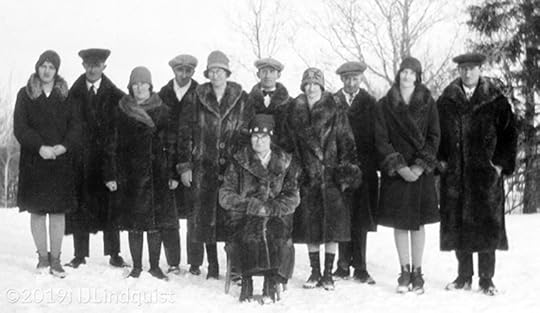
Dad's family somewhere in the 1950s. Lots of fur coats or collars! From left, Jean, George, Grace, Robert, Agnes, Walter, Margaret, Bill, Sarah, and Lorne (I hope I got them right!) Their mother, Jennie Shaw, is seated in front.
As you can see by the above picture of Dad's family, most of whom were not particularly well-off financially, fur coats were very popular at that time for everyone who lived in areas where the winters were cold. Presumably, Dad thought he could find a way to make some more money by getting involved.
By the 1950s, estimated sales of mink were worth three to four times as much in money terms as all other furs put together. Some six million mink were being ‘produced’ annually by this time.
https://www.historytoday.com/archive/skin-deep-fall-fur
https://archive.macleans.ca/article/1945/3/15/fur-boom
I have no idea how Dad connected with the other man who became his business partner, or whether it was someone from Indian Head or from Wolseley, but Dad and Mom decided this was their big chance and went for it. Since Dad had grown up on a farm, I assume he felt he had some idea of what was involved. I also don't know if they bought a mink farm or started their own.
The only picture I have of the buildings is one taken in mid-winter. The mink pens appear to be partially underground, but I have no idea how deep the snow was. From the tire tracks, it looks as if the snow has been brought over and packed against the buildings to act as insulation.
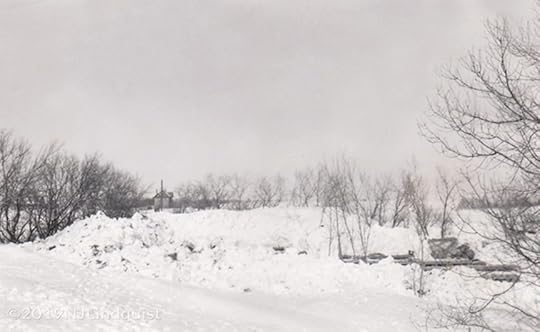
Mom hardly ever went near the mink, so I didn’t either. I think dad took me with him a few times.
My only memory of the mink farm is a dark building with cement floors and rows of cages with slinky animals whose black eyes glittered. I believe the cages were on shelves that were higher than me, so I had to look up. Or they might have been stacked.
The whole building had a smell I didn’t much like. I don’t remember any sounds other than the rustling.
I was told not to get close to the cages because the mink might bite. I didn’t like being there and got out as soon as possible.
A short video from a mink farm.
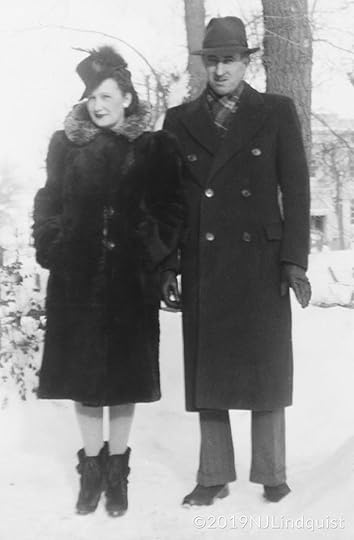
On the left is Mom in her previous winter coat, which I believe was dyed lamb with a sheared lamb collar.
On the right is Mom wearing a new coat, which I think was beaver.
This is the first picture I have of us that says we were in Wolseley. It was taken on December 15, 1949.
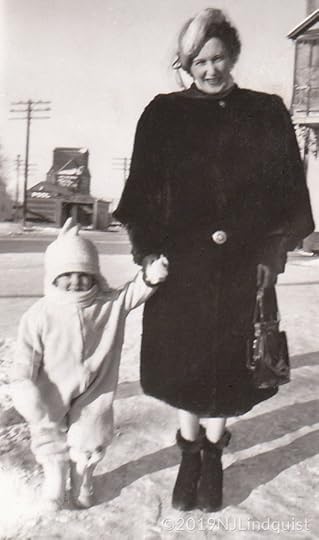
I believe lamb was cheaper that beaver, and beaver and muskrat were much less expensive than mink. So Mom had moved up from lamb to beaver.
I had no idea Mom's fur coat was made from the skins of animals. All I knew was that it felt very soft and it must be warm. But my knowledge was about to be expanded.
At some point in the first year or so, Dad had mink stoles (or scarves or tippets) made for Mom and me.
My stole consisted of a single golden-brown mink pelt that was joined at the front by a clasp with a hook on one end and a loop on the other. The animal’s head and tail were still there, although black beads had replaced its eyes.
While the fur felt soft and warm to touch, I could barely manage to look at it, never mind wear it. Mom would put it on me to go to church or visiting, and I'd feel sick the whole time. I avoided touching it because when I did all I could think about was that this was a living animal that had been killed so I could wear its fur. And it wasn’t even as though the stole kept me warm. It was purely for appearance.
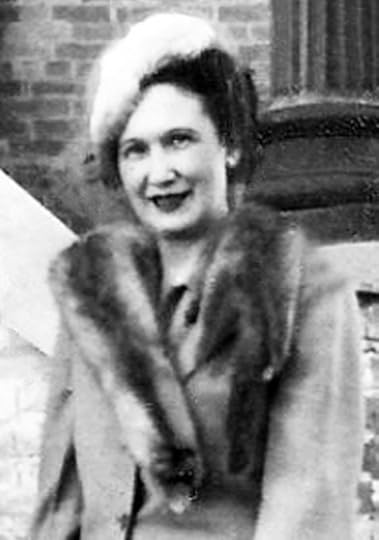
Mom loved her stole, which was basically the same as mine except darker and made from two larger pelts. Of course, she’d have preferred an entire mink coat, but Dad was raising the mink to make money, not to get her a new coat.
Mom kept both stoles in a special hat box on a shelf in her closet, and every time I was in her bedroom when her closet door was open, my eyes would be drawn to it. I really hoped Mom would forget the box was there. I was so glad when I was finally able to convince her that my stole was too small for me to wear.
Our Living Conditions Also ChangedFrom my perspective, our lives continued much as before, except that instead of living in a house, we lived in an apartment above a store on one of the two main streets of the village.
As well, our house in Indian Head had had a yard with grass I could play on. The children who lived in the apartments above the stores played in an alleyway behind the buildings, which was basically hard-packed dirt. As I'll show you in my next post, the challenge of not getting dirty had been ramped up.
*Huge thanks to Billy Shaw, the son of Robert Shaw (George Brown Shaw's nephew), who sent me photocopies of two letters my grandmother had written to his dad in Ballymacarn, County Down, Ireland, dated Dec. 6, 1948 and April 12, 1949.
Can You Relate?
For my parents, this was just one in a series of moves. It was the first for me in one way, but also the third. I'd already moved from the Salvation Army home in Regina where I'd lived with my birth mother to the home of a foster parent, and from there to Indian Head with my adoptive parents. Now I was going to a new town, but with the same parents.
Have you lived in the same area your whole life, or have you made a few or a lot of moves? Have you ever thought about how staying in one place or moving has affected you?
@media (min-width: 300px){.thrv_symbol_10531 [data-css="tve-u-1656479a734"] { width: 100px; float: none; margin-left: auto !important; margin-right: auto !important; margin-top: 0px !important; border: 1px solid rgb(0, 0, 0); box-shadow: rgba(0, 0, 0, 0.4) 0px 8px 12px 0px; }.thrv_symbol_10531 [data-css="tve-u-1656479a731"] { margin-left: 9px !important; }.thrv_symbol_10531 [data-css="tve-u-1656479a730"] { max-width: 57.4%; }.thrv_symbol_10531 [data-css="tve-u-1656479a733"] { max-width: 42.6%; }.thrv_symbol_10531 [data-css="tve-u-1656479a72f"] { max-width: 820px; float: none; width: 100%; margin-left: auto !important; margin-right: auto !important; }.thrv_symbol_10531 [data-css="tve-u-1656479a72e"] { min-height: 245px; }:not(#tve) .thrv_symbol_10531 [data-css="tve-u-1656479a734"] { width: 252px; }:not(#tve) .thrv_symbol_10531 [data-css="tve-u-1656d159d04"] { font-size: 18px !important; }:not(#tve) .thrv_symbol_10531 [data-css="tve-u-1656d159d06"] { font-size: 18px !important; }:not(#tve) .thrv_symbol_10531 [data-css="tve-u-1656d15d51d"] { max-width: 679px; float: none; width: 100%; margin-left: auto !important; margin-right: auto !important; }:not(#tve) .thrv_symbol_10531 [data-css="tve-u-1656d15d51d"] > .tve-cb { justify-content: center; display: flex; flex-direction: column; }:not(#tve) .thrv_symbol_10531 [data-css="tve-u-1656d16fbe9"] { float: none; width: 100%; margin-left: auto !important; margin-right: auto !important; }:not(#tve) .thrv_symbol_10531 [data-css="tve-u-1656d1795e1"] { font-size: 18px !important; line-height: 0.35em !important; }:not(#tve) .thrv_symbol_10531 [data-css="tve-u-1656d17bf7c"] { line-height: 0.6em !important; color: rgb(113, 30, 30) !important; }}
LoveChild: Life Lessons from an Ugly Duckling is the story of my struggle to adjust to the life I was given, and my eventual discovery that, not only had I become a swan but, contrary to my perceptions, I had always been one. Though I didn't realize it until many years later, my life was part of a much bigger plan that all made perfect sense.
I'll be blogging my story once a week.
Find links to all these blogs at:
https://www.njlindquist.com/lovechild/

@media (min-width: 300px){.thrv_symbol_10531 [data-css="tve-u-1656479a734"] { width: 277px; float: none; margin-left: auto !important; margin-right: auto !important; margin-top: 0px !important; }.thrv_symbol_10531 [data-css="tve-u-1656479a731"] { margin-left: 9px !important; }.thrv_symbol_10531 [data-css="tve-u-1656479a730"] { max-width: 57.4%; }.thrv_symbol_10531 [data-css="tve-u-1656479a733"] { max-width: 42.6%; }.thrv_symbol_10531 [data-css="tve-u-1656479a72f"] { max-width: 820px; float: none; width: 100%; margin-left: auto !important; margin-right: auto !important; }.thrv_symbol_10531 [data-css="tve-u-1656479a72e"] { min-height: 245px; }:not(#tve) .thrv_symbol_10677 [data-css="tve-u-1656479a734"] { width: 252px; }:not(#tve) .thrv_symbol_10677 [data-css="tve-u-1656d159d04"] { font-size: 18px !important; }:not(#tve) .thrv_symbol_10677 [data-css="tve-u-1656d159d06"] { font-size: 18px !important; }:not(#tve) .thrv_symbol_10677 [data-css="tve-u-1656d15d51d"] { max-width: 679px; float: none; width: 100%; margin-left: auto !important; margin-right: auto !important; }:not(#tve) .thrv_symbol_10677 [data-css="tve-u-1656d15d51d"] > .tve-cb { justify-content: center; display: flex; flex-direction: column; }:not(#tve) .thrv_symbol_10677 [data-css="tve-u-1656d16fbe9"] { float: none; width: 100%; margin-left: auto !important; margin-right: auto !important; }:not(#tve) .thrv_symbol_10677 [data-css="tve-u-1656d1795e1"] { font-size: 18px !important; line-height: 0.35em !important; }:not(#tve) .thrv_symbol_10677 [data-css="tve-u-1656d17bf7c"] { line-height: 0.6em !important; color: rgb(113, 30, 30) !important; }:not(#tve) .thrv_symbol_10677 [data-css="tve-u-165876ba63a"] button { background-image: none !important; background-color: rgb(113, 30, 30) !important; }.thrv_symbol_10677 [data-css="tve-u-165876ba639"] { max-width: 515px; float: none; margin-left: auto !important; margin-right: auto !important; }:not(#tve) .thrv_symbol_10677 [data-css="tve-u-16587b55abb"] { font-size: 22px !important; }}
Have my new posts sent directly to your inbox.
Sign Up to Have All My New Posts Sent to Your Inbox
The post LoveChild 22: Big Changes in Our Lives appeared first on N. J. Lindquist.
December 18, 2019
LoveChild 21: Growing Pains
“A person's a person, no matter how small.”
Dr. Seuss, Horton Hears a Who
Our Second Year Together Isn't Quite as Idyllic as the First
As I documented in earlier posts on here (three to seven), for the first year after Bob and Margaret took me home with them, everything went quite well.
They were thrilled to have their very own baby, and once my digestion problems had been more or less resolved and it was clear that Bozo was going to protect me, not hurt me, life was good.
But as we entered the spring of my second year, even while my adoption was being finalized, the happy excitement that had enveloped the euphoric first year began to dissipate, and a few scattered clouds appeared on the horizon.
Don't get me wrong. They were thrilled to have a healthy, happy daughter who was walking and talking earlier than most children. But that brought with it some uncomfortable moments.
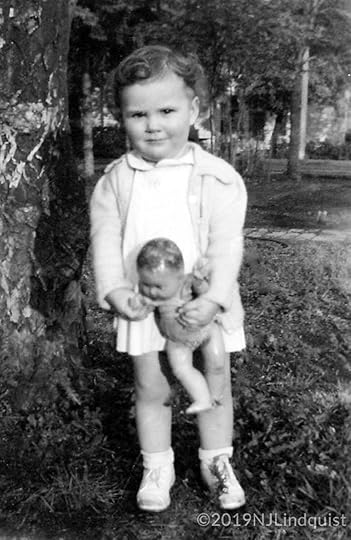
Early spring, 1949. One of many pictures of me with a doll. Unfortunately, all my dolls seem to have had very limited wardrobes.
As was the norm in those days, the bulk of responsibility for looking after me fell on my mother’s shoulders.
Stores were only open until six at night, and closed on Wednesday afternoons. (By the way, they also often closed from noon until one for lunch.) But they might be open late Saturday because that was the day farmers tended to come to town. So Bob/Dad was at his butcher shop from early morning until evening on most days of the week.
Plus, because of the nature of his job, Dad had to work extra hours in the morning or evening cutting up the sides of beef or pork for selling. As a result, except for Sunday, when the stores were closed, Dad saw me during lunch, and occasionally at breakfast and supper.
Margaret/Mom made sure I was in bed by seven p.m. because someone (possibly Dr. Spock) had told her that babies need a lot of sleep and should be in bed by seven. Consequently, my waking moments were mostly spent with Mom, and she was the one who had to look after all of my needs.
As I grew older, three issues in particular became more and more frustrating for her.1. Beginning at eight months, I began to transform from a happy, compliant baby into a toddler with a mind of her own. First, I started crawling and getting into things.Before long, I began to shake my head with determination when I didn’t want to do something.I then began to talk, starting with “Dada” and “eggie” but not “Mama.”By ten months of age, I was walking.By my first birthday, I was shouting “No” and running away.By the time I was fourteen months old, I was climbing all over, and constantly getting into trouble.
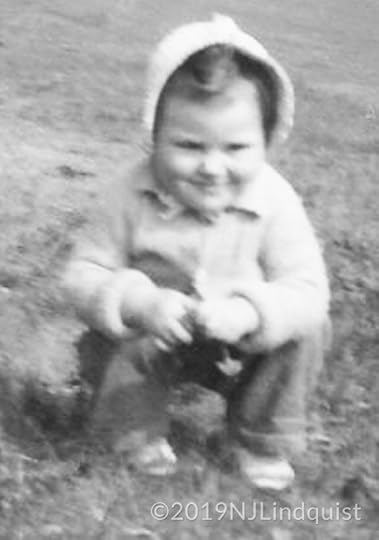
Do you see the mischief in those eyes? I'm planning something. And my mother isn't going to be happy about it.
By eighteen months, I no longer needed a nap, so Mom didn't get that reprieve after lunch.2. The second troublesome issue was my propensity to get my clothes dirty.
If I think about it really hard, my mind can still call up echoes of her voice, edged with annoyance, saying, “Nancy, don’t get dirty!” Unfortunately, I wasn’t particularly successful at obeying this edict.
Mom told me later that I only ever had one pair of overalls. I don’t know if she wasn’t able to find a suitable pair in the handful of dry goods stores in the small towns we lived in, or if there wasn’t enough money to buy a second pair. She didn’t sew, so making my clothes wasn’t an option.
The picture here shows me at 16 months in my overalls, and with my dolls, which comprised most of my toys.
Even in her eighties, Mom still complained a few times about having to wash my overalls out by hand every night so that I could wear them again the next day.
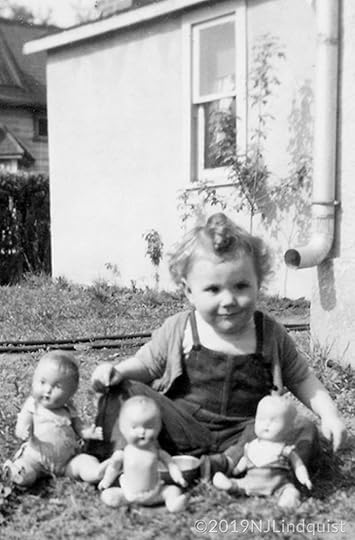
Summer, 1949. Me, my overalls, and my dolls, who are wearing a few clothes.
In addition to my one pair of overalls, I had a few dresses, most in pale colours: white, light pink, light blue. Many had been gifts from friends and family when I arrived. A few were gifts for my first Christmas. With the dresses, I wore white socks and shoes, as you can see from this picture.
After a while, I think Mom became resigned to the fact that the overalls would get dirty, but she really got upset when I got my dresses dirty, because they were much harder to get stains out of, and ironing them was much more work.
Back then, Mom would rinse out a few small items in the plastic basin she used to bathe me, scrub larger, dirtier items with a washboard in a larger square galvanized steel wash tub, or do the weekly washing in a wringer washing machine they kept in the basement, where you used the same water for several loads. Getting out the tub or loading the washer was a pain, so she usually washed small items in the basin in the kitchen sink.
There were no dryers in those days, so everything—sheets, underwear, and all—had to be hung on a clothesline outside. After that, you ironed pretty well everything, because most clothes were made of cotton or other fabrics that wrinkled. Mom even ironed the dishtowels and sheets.
And, yes, the diapers she'd used were cloth, and also had to be washed and hung to dry, although I’m not sure if she ironed them. Come to think of it, she probably did.
It’s also possible—no, probable—that the source of a good deal of Mom’s frustration about my getting dirty was that she had to scrape and save to manage her household on what Dad made in the butcher shop.
According to the Application for Adoption, Dad had been earning around $3,000 a year. In 1948, from what I’ve found on the Internet, that was slightly below average. (http://1940s.org/history/)
Out of that $3,000, he had to pay rent for their house, gas and upkeep of his car (and likely payments), food, clothes, any furnishings they needed, and so forth.
Married women didn’t usually get jobs outside the home in those days. They tended to look after the house and the children and the laundry and the meals and other household duties while the men worked. It’s just the way things were. (More about that later.)
By the way, in case, this amount of income sounds strange. I found this on the Internet.
The cost of living in 1949
Car: $1,650
Gasoline: 26 cents/gallon
House: $14,500
Bread: 14 cents/loaf
Milk: 84 cents/gallon
Postage Stamp: 3 cents
Average Annual Salary: $3,600
Minimum Wage: 40 cents per hour
According to Dave's Inflation Calculator, $3,000 in 1948 would be equivalent to $31,250.00 in 2019.
Of course, when I was young, I had no idea about any of this. All I knew was that Mom seemed to be overly-concerned about my getting dirty when I was playing, and that sometimes I had to choose between satisfying my curiosity at the risk of getting dirty and being a bad girl, or playing quietly with my dolls and being a good girl.
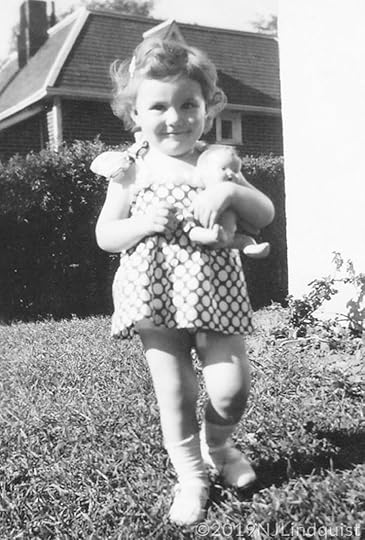
Summer, 1949. Dressed up and ready to go visiting with my doll. I was hoping there would be cookies.
After lunch, Mom and I usually went visiting or shopping, or had one of her friends over. Before that happened, Mom dressed up herself, and changed me out of my overalls and into a dress. Naturally, I hated nothing more than having to wear a dress and white socks and shoes.
And that part of the problem wasn’t going to go away. It was, in fact, going to become a major tug-of-war as I became older and more able to articulate my preferences.
Which leaves me wondering. Did my dislike for dresses come from the fact that I associated them with the whole “don’t get dirty/behave/be a good girl” meme, or did I have an inborn style that affected how I viewed the whole dressing-up thing?
In other words, is my dislike of wearing dresses, even today, a “nature” thing or a “nurture” thing?
However, all of Mom’s admonitions about not getting dirty actually paled in comparison to a related issue.
3. The third thing that drove a huge spike into any chance Mom and I had for a symbiotic relationship was my curiosity.
My toys during the first two years consisted of a few dolls that had one outfit each, a drum which I wasn’t allowed to play with very much, several cooking pots and a large spoon so I could pretend to cook while Mom was working in the kitchen (and also made a good drum), a couple of pull toys, a few stuffed animals, and a handful of picture books. Not quite enough stimulation for a child with endless curiosity.
The one thing that kept me entertained and even quiet was having someone read to me from one of my books. My favourite was a book of nursery rhymes, and before the age of two, I was not only talking in complete sentences, but also reciting nursery rhymes I’d memorized. (“Little Bo-Peep,” “Baa Baa Black Sheep,” Mary, Mary, Quite Contrary,” and “Old Mother Hubbard” are a few I remember well.)
Mom had a lot of friends, most of whom had children who were older than me, and she was in the habit of visiting one or another of her friends most afternoons for tea. If not, Mom might have a friend in for tea or we’d go “downtown” (a walk of only a few blocks) to buy bread or some other necessity.
Most mornings, I’d play in my overalls while Mom did her housework. After lunch, she’d change me into one of my dresses and comb my hair. As my hair grew longer, she tried using small barrettes to hold it in place; but she had nothing other than her voice and her hands to hold me in place.
You'll notice that in many of the pictures of me between the ages of ten months to three years, my mother is firmly holding my hand to keep me beside her, and I’m not looking very happy.
When we visited one of Mom’s friend’s house, I tended to wander off, poking my head around corners, going into other rooms, opening doors and drawers, and, all-too-often, taking things apart. Most of her friends laughed and said not to worry, but Mom was mortified. Her embarrassment grew as I learned more words and continued to say whatever I was thinking with innocent accuracy.
And no matter that they said, I expect she was concerned that her friends secretly thought she was inadequate as a mother.
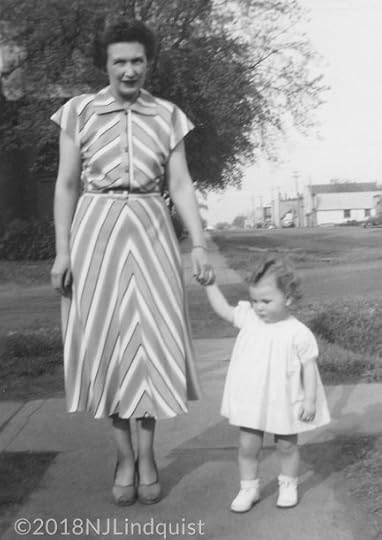
The look on my face says it all.
Mom had felt incomplete without a child, but the reality of having a living, breathing daughter wasn’t quite what she’d expected.
I truly believe that, in her mind, she’d envisioned her daughter as a delightful child who sat quietly, did as she was told, spoke only when addressed, and generally behaved like a genteel, miniature adult. Maybe that was what she herself had been like.
She seemed to have no framework for dealing with a rambunctious little girl who could barely sit still for two minutes, had no filter for the thoughts she spoke out loud, ignored reprimands, screamed when frustrated, tried to escape when cornered, and found endless new ways to get into trouble.
As I think about it now, it was sad for both of us. Expectations can be useful in helping us create goals and plans; unrealistic expectations, however, can set us up for depression and a feeling of failure.
Were our differences trivial? Or were they in fact an essential part of our personalities?
Which, of course, leads to the whole nature vs nurture debate.
How much of who we are was determined by our genes and how much by our parents and the world we lived in?
Would I have become the person I am today if I’d been raised by my birth family? If I’d been adopted by different people?
Would my mother have been a different person if she'd been the youngest of seven instead of hte oldest? if she'd stayed home and finished school instead of leaving to get a job?
Having given birth to four sons, each of whom had his own unique personality from the day he was born, I can attest to the fact that we are born as fully formed individuals with unique personalities. As we interact with the world we live in, there is a constant tension as we strive to do our best to become who our genes have determined we ought to be, but also to adapt to or work around the world we live in and the people in our lives.
So, I believe that certain things about me wouldn’t have changed. But how those things worked in a different setting might have changed. For example, if I’d been adopted by a family with four other children, instead of being an only child, there would have been obvious relational things I’d have had to adapt to.
Note:
Mom told me at least three times—once when I was in my teens, after my second son was born, and when she was older—that they’d originally wanted to adopt a second child—a boy—so I’d have a sibling. But before I’d turned two, they made the difficult decision that they just couldn’t afford a second child. I now wonder if Mom felt she couldn't handle having two children if the second one was anything like me.
Can You Relate?
Have you ever thought about how your personality impacted your parents and vice versa?
Or how you and your children/grandchildren impact each other?
@media (min-width: 300px){.thrv_symbol_10531 [data-css="tve-u-1656479a734"] { width: 100px; float: none; margin-left: auto !important; margin-right: auto !important; margin-top: 0px !important; border: 1px solid rgb(0, 0, 0); box-shadow: rgba(0, 0, 0, 0.4) 0px 8px 12px 0px; }.thrv_symbol_10531 [data-css="tve-u-1656479a731"] { margin-left: 9px !important; }.thrv_symbol_10531 [data-css="tve-u-1656479a730"] { max-width: 57.4%; }.thrv_symbol_10531 [data-css="tve-u-1656479a733"] { max-width: 42.6%; }.thrv_symbol_10531 [data-css="tve-u-1656479a72f"] { max-width: 820px; float: none; width: 100%; margin-left: auto !important; margin-right: auto !important; }.thrv_symbol_10531 [data-css="tve-u-1656479a72e"] { min-height: 245px; }:not(#tve) .thrv_symbol_10531 [data-css="tve-u-1656479a734"] { width: 252px; }:not(#tve) .thrv_symbol_10531 [data-css="tve-u-1656d159d04"] { font-size: 18px !important; }:not(#tve) .thrv_symbol_10531 [data-css="tve-u-1656d159d06"] { font-size: 18px !important; }:not(#tve) .thrv_symbol_10531 [data-css="tve-u-1656d15d51d"] { max-width: 679px; float: none; width: 100%; margin-left: auto !important; margin-right: auto !important; }:not(#tve) .thrv_symbol_10531 [data-css="tve-u-1656d15d51d"] > .tve-cb { justify-content: center; display: flex; flex-direction: column; }:not(#tve) .thrv_symbol_10531 [data-css="tve-u-1656d16fbe9"] { float: none; width: 100%; margin-left: auto !important; margin-right: auto !important; }:not(#tve) .thrv_symbol_10531 [data-css="tve-u-1656d1795e1"] { font-size: 18px !important; line-height: 0.35em !important; }:not(#tve) .thrv_symbol_10531 [data-css="tve-u-1656d17bf7c"] { line-height: 0.6em !important; color: rgb(113, 30, 30) !important; }}
LoveChild: Life Lessons from an Ugly Duckling is the story of my struggle to adjust to the life I was given, and my eventual discovery that, not only had I become a swan but, contrary to my perceptions, I had always been one. Though I didn't realize it until many years later, my life was part of a much bigger plan that all made perfect sense.
I'll be blogging my story once a week.
Find links to all these blogs at:
https://www.njlindquist.com/lovechild/

@media (min-width: 300px){.thrv_symbol_10531 [data-css="tve-u-1656479a734"] { width: 277px; float: none; margin-left: auto !important; margin-right: auto !important; margin-top: 0px !important; }.thrv_symbol_10531 [data-css="tve-u-1656479a731"] { margin-left: 9px !important; }.thrv_symbol_10531 [data-css="tve-u-1656479a730"] { max-width: 57.4%; }.thrv_symbol_10531 [data-css="tve-u-1656479a733"] { max-width: 42.6%; }.thrv_symbol_10531 [data-css="tve-u-1656479a72f"] { max-width: 820px; float: none; width: 100%; margin-left: auto !important; margin-right: auto !important; }.thrv_symbol_10531 [data-css="tve-u-1656479a72e"] { min-height: 245px; }:not(#tve) .thrv_symbol_10677 [data-css="tve-u-1656479a734"] { width: 252px; }:not(#tve) .thrv_symbol_10677 [data-css="tve-u-1656d159d04"] { font-size: 18px !important; }:not(#tve) .thrv_symbol_10677 [data-css="tve-u-1656d159d06"] { font-size: 18px !important; }:not(#tve) .thrv_symbol_10677 [data-css="tve-u-1656d15d51d"] { max-width: 679px; float: none; width: 100%; margin-left: auto !important; margin-right: auto !important; }:not(#tve) .thrv_symbol_10677 [data-css="tve-u-1656d15d51d"] > .tve-cb { justify-content: center; display: flex; flex-direction: column; }:not(#tve) .thrv_symbol_10677 [data-css="tve-u-1656d16fbe9"] { float: none; width: 100%; margin-left: auto !important; margin-right: auto !important; }:not(#tve) .thrv_symbol_10677 [data-css="tve-u-1656d1795e1"] { font-size: 18px !important; line-height: 0.35em !important; }:not(#tve) .thrv_symbol_10677 [data-css="tve-u-1656d17bf7c"] { line-height: 0.6em !important; color: rgb(113, 30, 30) !important; }:not(#tve) .thrv_symbol_10677 [data-css="tve-u-165876ba63a"] button { background-image: none !important; background-color: rgb(113, 30, 30) !important; }.thrv_symbol_10677 [data-css="tve-u-165876ba639"] { max-width: 515px; float: none; margin-left: auto !important; margin-right: auto !important; }:not(#tve) .thrv_symbol_10677 [data-css="tve-u-16587b55abb"] { font-size: 22px !important; }}
Have my new posts sent directly to your inbox.
Sign Up to Have All My New Posts Sent to Your Inbox
The post LoveChild 21: Growing Pains appeared first on N. J. Lindquist.
December 10, 2019
LoveChild 20: Bob and Margaret – The Years Before Me
“They say a person needs just three things to be truly happy in this world: someone to love, something to do, and something to hope for.”
Tom Bodett
Life in Indian Head
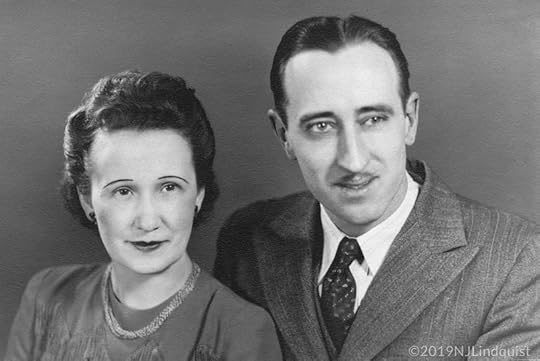
Not sure when this photo was taken, but I assume sometime between 1944 and 1946. This was the photo that was on display instead of their wedding photo. The moustache seems to have been tried out a few times before Bob finally settled on keeping it.
With Bob owning his own butcher shop, and Margaret adjusted to her new life as a homemaker, life settled into a routine.
Bob worked long hours, with a half-day on Wednesday and the day off on Sunday. He'd often take Bozo to work with him, select some meat for lunch, attach it to Bozo's collar, and then send him home to Margaret so she could cook the meat for lunch. Back then, most businesses closed for lunch, so he could walk home, rest for a few minutes, and then walk back to work.
As soon as he could afford it, Bob hired someone to work part-time so he could get away for a few hours or a few days when needed.
In the morning, Margaret made their bed, got breakfast ready, did her housework, cooked lunch (which was the biggest meal of the day), and then visited one of her friends or had someone over in the afternoon. She'd be home in time to make supper.
In the evenings, they had at least one newspaper to read, as well as a radio to listen to for news and entertainment. World War II was still going on, so there was lots of news to discuss and worry about.
They also participated in local events, including a movie now and then, going to a dance, or a party at someone's house. In the summer, they might drive the 15 miles north to Lake Katepwa, in the Qu'Appelle Valley, for a quick visit with some of their friends who owned a cottage.
When he was growing up, Bob had picked up an accordion and a banjo, and although he never played either well enough to be in a band, he got some enjoyment from playing and singing for himself and a few friends. "Oh, Susannah" was a favourite.
"Five Foot Two, Eyes of Blue" was his song for Margaret. The first line is, "Five foot two, eyes of blue, but oh what those five feet can do, Has anybody seen my gal?" While her eyes were brown, she was exactly five feet, two inches tall.
On Sundays, they attended the United Church in the mornings. They also attended any special events (fall suppers, ladies teas, etc.) at the church.
Staying in Touch with Margaret's FamilyWhile they may not have had a car yet, Margaret wrote letters and they were able to take a bus ride for an occasional visit with their family members and friends. They might make a quick phone call for anything really important. Long distance calls were expensive.
Margaret's brother Hughie and his wife Oral and their son seem to have lived in Yorkton for a short time before moving to Winnipeg. Yorkton was about 85 miles (136 km) northeast of Indian Head.
Occasionally, family members came by bus to visit them.
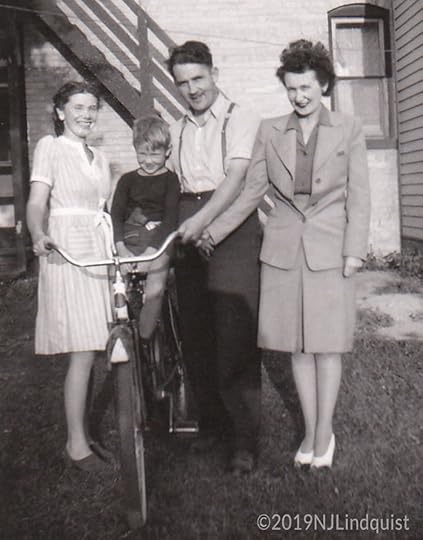
Oral, Dale, and Hughie MacDonald, Margaret in Yorkton, 1942-3.
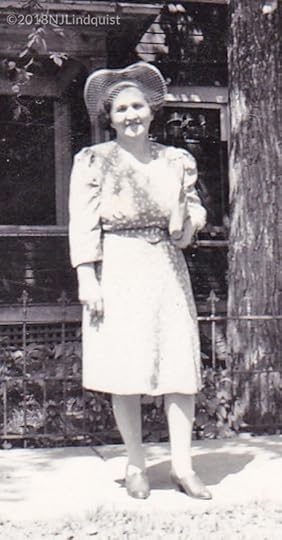
Alice MacDonald in Indian Head, 1945
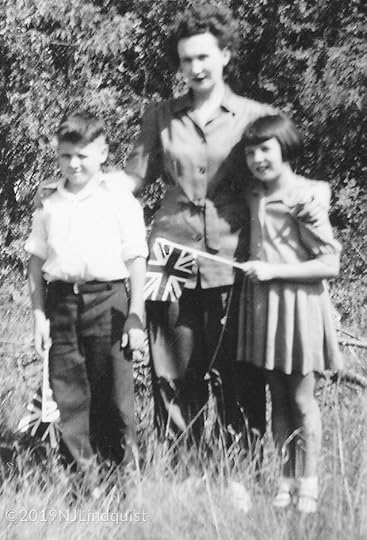
Margaret with her brother Terry and sister Fay at Indian Head, 1945.
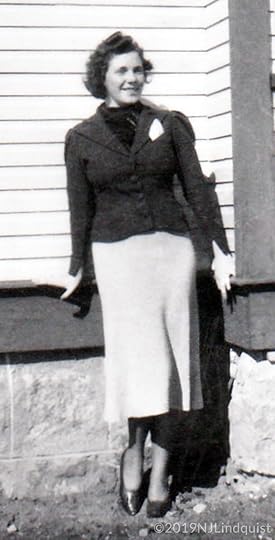
Margaret's sister Brucie, 1945.
Winnipeg, where Margaret's mother Alice MacDonald moved not along after her husband's death, was roughly 318 miles (512 km) past Brandon. Margaret's aunts Maudie and Ettie lived in Winnipeg, as well as her brothers Jim and Mervin and younger siblings. And Hughie moved there as well.
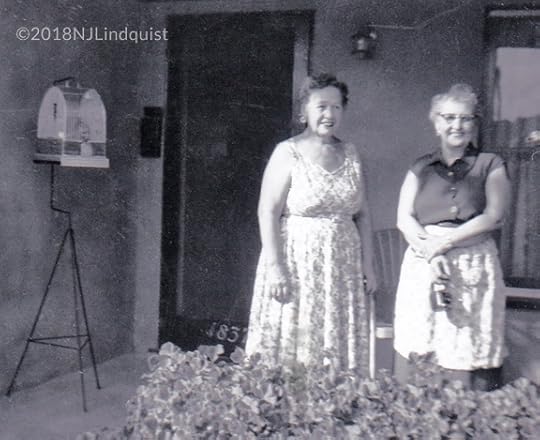
Margaret's aunts Ethel (Ettie) Hawkes and Maude (Maudie) McTaggart.
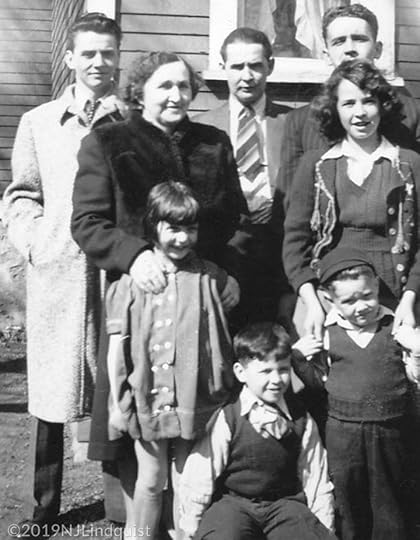
Back row Mervin, Jim, and Hughie; middle row Alice and Brucie; front row Fay, Terry, and Dale (Hughie's son). 1943 in Winnipeg.
Margaret's youngest sister, Fay, remembers travelling to Winnipeg on a bus not long after her father died. She'd have been five. There was no insurance, and there were no savings. The building where Bruce had had his barber shop and pool hall were likely rented.
But Alice's sisters Ettie and Maudie, and her oldest sons as well as Margaret and Bob would have done what they could to help.
For a time, Alice and the children lived in Maude's house, which was set up as a boarding house. Maudie's husband Mac had been a station master and telegrapher for the CPR and continued to work for them in Winnipeg until he retired. Since Maudie took in boarders, she had a couple of rooms she could rent to them.
A year or so later, Margaret's next younger brother, Jim, married, and he and his wife rented a house and rented the second floor to Alice and her three youngest children. It was crowded, but they managed.
At the time, Jim was working in a cordite plant (where "acid, nitroglycerine, and guncotton (nitrocellulose) were manufactured as ingredients in cordite, an explosive.") He later enlisted in the dental corps of the army, but never saw overseas duty.
While he was in the army, Jim's wife divorced him, and Alice and the children had to find another place to live.
Alice's son, Mervin soon married, and he had room for them in his house for a while.
Alice and her three youngest children lived in a variety of different apartments over the years. Holidays were usually spent at Maudie's house.
Brucie got a job in the candy department at Woolworths in downtown Winnipeg when she was 14. She'd take the trolley to get there after school and on Saturdays. Later, she got a job as a secretary.
Terry started working when he was 12, first doing deliveries for a pharmacy, then working as a soda jerk until he got a full-time job.
Fay also started work when she was 12, helping out in the convenience store one of Maudie's boarders owned in their neighbourhood. Later, she worked in a general bakery, and then in McGavins Bakery, as a comptometrist.
Fay thinks her mom was able to get some help from welfare now and then as well. She also got a small amount from Jim's being in the army.
Staying in Touch with Bob's FamilyMany of Bob's siblings, aunts, uncles, and cousins lived in Rossburn, which was about 170 miles (270 km) east.
Bob's mother and several siblings lived in Brandon, which was roughly the same distance as Rossburn, but further south, on the Number 1 highway.
Some of them occasionally came to visit in Indian Head, too.
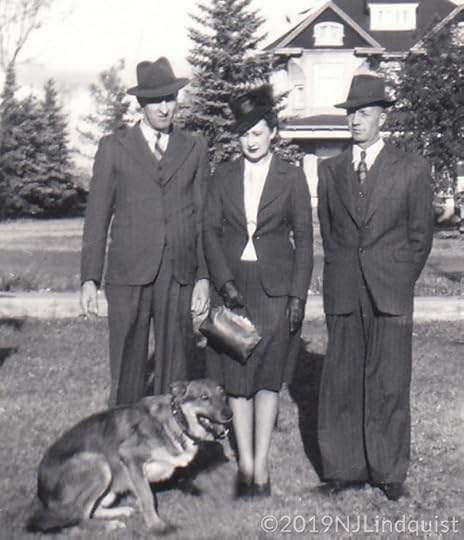
Bob and Margaret with Albert Roney and Bozo in Indian Head
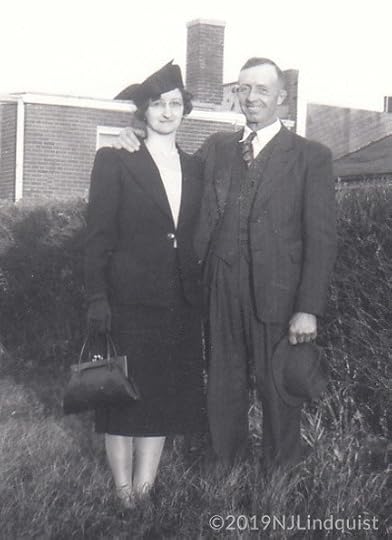
Bob's sister Margaret and her husband Albert Roney
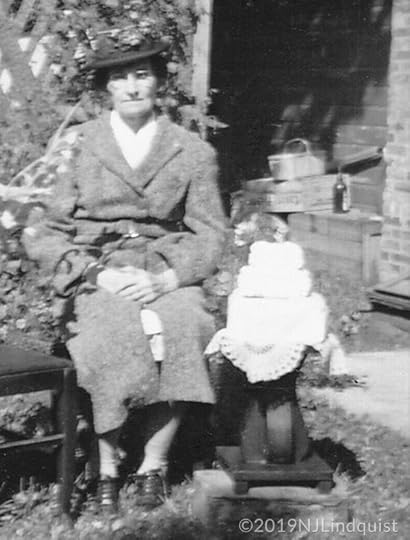
Jennie Shaw's 70th birthday in 1946. Maraget's mother, Alice, was 49 that year.
Bob and Margaret remained close to Bob's sister Jean (and Howard Maltby), Sarah (and Alf Mitchell), and Margaret (and Albert Roney), and kept in touch with Bob's other siblings, too.
They were also close to some of Bob's nieces and nephews, including Jim Shaw (the son of his Bob's oldest brother, George) and his wife Doris, and Agnes (Bob's sister) and Gordon Taylor's daughters Jennie (and Bud Amstrong) and Margaret (and Charlie Drummond), and their son Mac (and Merle) Taylor.
Their First CarOne of the few letters I have that Bob wrote was to Margaret in the summer of 1943. He was in Winnipeg and she was in Wapella. My guess is that she was staying with their friends, Eve and George Markham, who later moved to Moosomin. It seems strange to me that she wouldn’t have gone with him to visit her family.
In any case, this letter, written from Bob to Margaret on July 6, 1943 and postmarked July 7, 1943, was addressed to Mrs. R. A. Shaw, Wapella, Saskatchewan. It’s written in pencil on faded cream paper.
I’ve typed it as it was written, so you can see that spelling and punctuation definitely weren’t Bob’s strong point. When he had to write something for other people, he always got Margaret to do it.
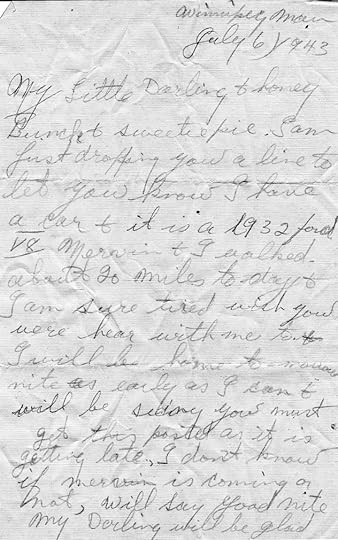
Bob's letter to Margaret July 6, 1943
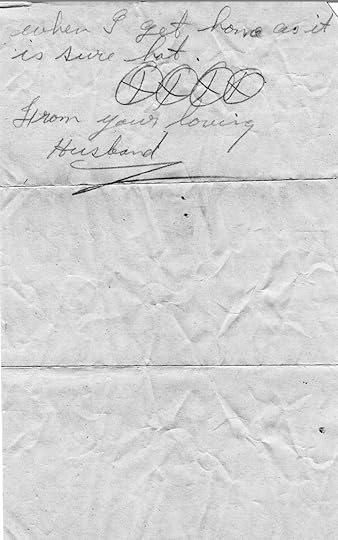
My Little Darling & honey Bunch and sweetie pie. I am just dropping you a line to let you know that I have found a car & it is a 1932 Ford V8. Mervin and I walked about 20 miles today so I am sure tired wish you were hear with me to.
I will be home tomorrow as early as I can & will be seeing you I must get this posted as it is getting late. I don’t know if Mervin is coming or not, Will say Good nite My Darling will be glad when I get home as it is sure hot.
(X)(X)(X)(X)
From your loving Husband
I find it interesting that Bob mailed the letter from Winnipeg and seemed to expect it to arrive in Wapella before he got there the next day!
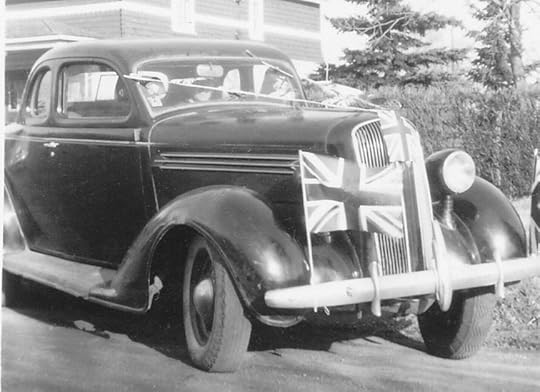
I assume this was Bob's first car, a 1932 Ford V8.
I'm not 100% positive that this was the first car Bob owned, but I expect it was because there are pictures of all the cars he had later on.
I'm sure he had learned to drive a tractor, and likely a truck, too, by the age of 12 or younger. He probably learned to drive from one or more of his brothers.
In later years, his car was very important to him. My guess is that he saw it as a bit of a status symbol. That certainly wouldn’t have been unusual in those days. Riding in a car was still a bit of a novelty.
On several occasions, Mom told me that her dad never owned a car and often sat looking out the window on a Sunday afternoon, longing for someone to stop by and offer to give him a ride. Not to go anywhere in particular—just to go out in a car.
All her life, Mom loved going for a ride. She and Dad often drove around our small town in the evening or on a Sunday afternoon. When I was at home, I usually went with them. That’s when they’d talk about the people who lived in the town and what was going on, and I'd listen from the back seat.
Margaret never learned to drive, although she was still talking about getting her license well into her seventies. In Winnipeg, when she was working, she hadn’t needed a car. She’d take the trolley downtown to work, and her fiance might have had a car, as did her aunts and uncles.
I asked her one day why she hadn’t learned to drive. She said that Bob tried to teach her after they got a car, but in those days every car had a gear shift—there were no automatics—and she had a lot of trouble getting the hang of shifting gears. Bob was afraid she was going to strip the gears on his car, so he simply stopped trying to teach her, and she apparently let it go. Why she didn’t try again when automatic gearshifts came out, I don’t know. Possibly by then it was fear of the unknown. And I expect by then she was nervous and used to Bob’s doing all the driving.
An Unexpected ProblemBob and Margaret had no doubt expected her to get pregnant fairly quickly. After all, Bob had nine siblings and Margaret had six. Of Bob's siblings, only his brother Lorne and sister Margaret had no children. Margaret's brother, Hughie, was married shortly after them, and he and his wife Oral soon had a baby boy. Bob's younger sister Jean, who had married the year before them, had become pregnant within the first year, and now had a daughter (Joan) and a son (Barry). Margaret's younger brother, Hughie, had a son, too.
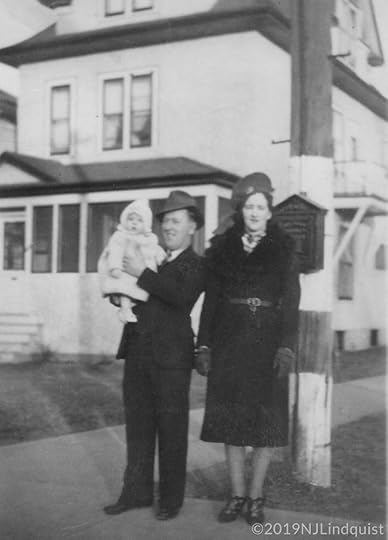
Howard and Jean Maltby with baby Joan in front of their house in Brandon in 1940.
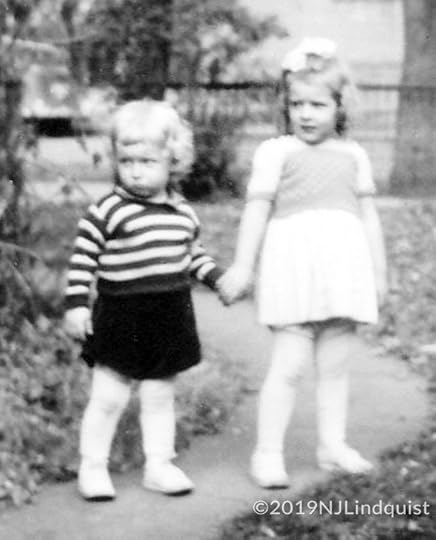
Barry and Joan Maltby - Jean and Howard's children, 1946.
However, Margaret hadn't become pregnant and in her early 30s, she'd begun having what was then termed “female troubles.” One year passed, and then the next, with no signs of pregnancy.
After several years of going to the doctor and trying various treatments, they decided that she needed a hysterectomy. At that time, this was major surgery, and could involve up to three or more weeks in hospital.
Margaret's friend, Eve Markham, who lived in Wapella at this time, was a public health nurse. My guess is that the reason Margaret stayed in Wapella with these friends in 1943 while Bob drove to Winnipeg was because she was recuperating from the hysterectomy.
Margaret rarely spoke about this time to me, other than to say that her life changed afterwards. Of course, the immediate result was that she was unable to have any children. But in the bigger picture, this period marked the beginning of a life-long string of visits to doctors for a variety of complaints, some of which were taken seriously and some of which she was told were “in her head.”
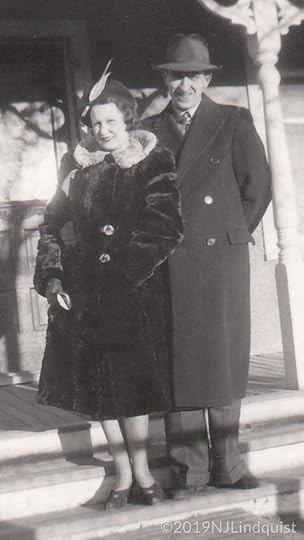
Bob and Margaret, 1942. No cares?

Bob and Margaret, 1944-5. They both look more serious.
Keeping Busy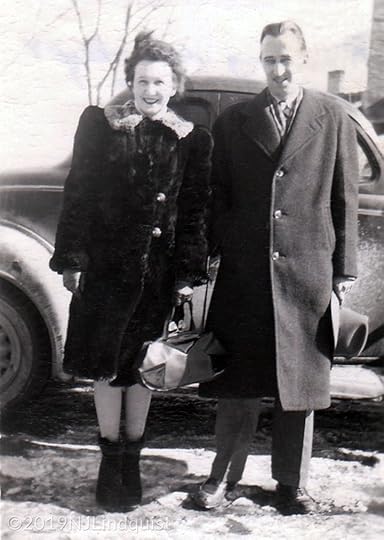
Leaving for Toronto, spring of 1946
This picture was taken in Indian Head in 1946, in what was either winter or early spring. World War II was over by then, and the country was getting back to normal. The picture was taken just before they left to go to Ontario. I believe the car behind them is the 1932 Ford Bob had bought in Winnipeg in 1943. My guess is he was driving it to a car dealer (either in Regina or Winnipeg) to trade it in. Then they’d take a train to Windsor, Ontario, where they’d pick up their new car and drive it home.
This was actually quite common in those days. Cars were made in Ontario and shipped out west. By driving it yourself, you saved transportation costs. Mom later told me short bits about the trip and some of the things they saw, like Casa Loma and Niagara Falls.
They both look happy in this picture.
The last picture I have of Margaret and Bob prior to my arrival was taken in the late summer or early fall of 1947, and you can see their new car in the background.
On the back of the picture Margaret wrote, See how brown Bob’s arms are. He got a good tan down at the lake. Note my extra weight.
The lake would be Lake Katepwa, near Indian Head, where a number of their friends had cottages.
The one thing Bob and Margaret definitely had was a lot of friends, many of whom remained close to them for life.
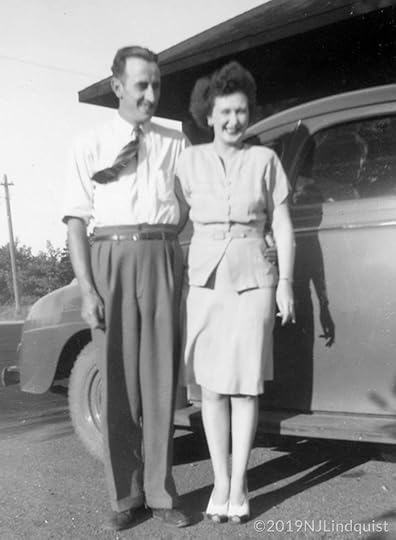
Summer of 1947 at Lake Katepwa
Adopting a Baby GirlAt some point, perhaps after the summer of 1947, Bob and Margaret felt they were ready to apply to adopt a baby. By this time, Margaret's brother Mervin and his wife Evelyn had a son, and Hughie and Oral were expecting a second son. Bob's brother Lorne and his wife Elsie, who were also childless, had decided to adopt as well.
I think they were very nervous about the whole thing. Likely anticipating everything that could go wrong. I strongly suspect that some of their friends—people like Eve Markham and Grace Horsman—persuaded them that they should adopt.
Margaret wanted a little girl, and Bob was fine with that. According to the adoption papers, which I was able to get from the Province of Saskatchewan Department of Social Welfare, Robert had averaged $3,000 a year for the last 5 years. That doesn't sound like much today, but it was actually slightly above average for that time.
What I do know for sure is that on March 3, 1948, my birth mother appeared in a juvenile court in Regina to say that she wanted her baby to be adopted, and that she was unwilling to keep me. The judge then ruled that I was "neglected" and made me a ward of the court, who was then suitable for adoption.
I was two months old. It would be 50 years before I found out how much my birth mother actually wanted to keep me, and why she let me be placed for adoption.
On March 25th, Bob and Margaret Shaw received a letter from the government. It gave them a little information about me (the baby) and my parents—information I would never see—and asked them to arrange to come and meet me in the next few days if they were interested.
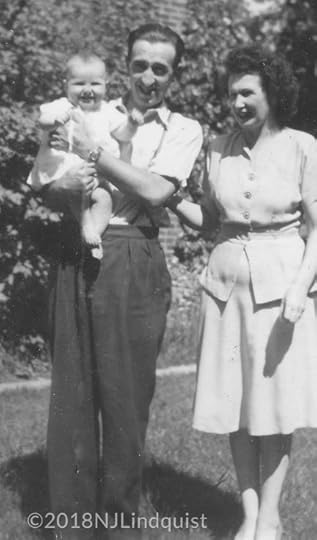
Bob and Margaret with me at not quite three months. Hard to tell who was the happiest.
On March 31st, 1948, Bob and Margaret drove from Indian Head to Regina (a little over 30 miles) to meet the baby girl they had been offered.
According to the social worker who brought them to see me, I was "a beautiful baby and in perfect condition. The Shaws thought she was a wonderful child and did not hesitate about taking her."
They drove me to their home in Indian Head that day. I would be placed in their home, and a caseworker would visit regularly. After a year, they could apply to make their guardianship permanent.
So these two people, who had known each other for all of six weeks before marrying and had waited nearly ten long years to start a family, adopted an almost three-month-old baby they had just met. Then they scrambled to learn how to raise this child who, while physically looking very much like their natural daughter, was actually nothing like either of them.
Can You Relate?
Most people know someone who adopted a child, gave a child up for adoption, or was adopted. When you think of "adoption," how do you feel?
@media (min-width: 300px){.thrv_symbol_10531 [data-css="tve-u-1656479a734"] { width: 100px; float: none; margin-left: auto !important; margin-right: auto !important; margin-top: 0px !important; border: 1px solid rgb(0, 0, 0); box-shadow: rgba(0, 0, 0, 0.4) 0px 8px 12px 0px; }.thrv_symbol_10531 [data-css="tve-u-1656479a731"] { margin-left: 9px !important; }.thrv_symbol_10531 [data-css="tve-u-1656479a730"] { max-width: 57.4%; }.thrv_symbol_10531 [data-css="tve-u-1656479a733"] { max-width: 42.6%; }.thrv_symbol_10531 [data-css="tve-u-1656479a72f"] { max-width: 820px; float: none; width: 100%; margin-left: auto !important; margin-right: auto !important; }.thrv_symbol_10531 [data-css="tve-u-1656479a72e"] { min-height: 245px; }:not(#tve) .thrv_symbol_10531 [data-css="tve-u-1656479a734"] { width: 252px; }:not(#tve) .thrv_symbol_10531 [data-css="tve-u-1656d159d04"] { font-size: 18px !important; }:not(#tve) .thrv_symbol_10531 [data-css="tve-u-1656d159d06"] { font-size: 18px !important; }:not(#tve) .thrv_symbol_10531 [data-css="tve-u-1656d15d51d"] { max-width: 679px; float: none; width: 100%; margin-left: auto !important; margin-right: auto !important; }:not(#tve) .thrv_symbol_10531 [data-css="tve-u-1656d15d51d"] > .tve-cb { justify-content: center; display: flex; flex-direction: column; }:not(#tve) .thrv_symbol_10531 [data-css="tve-u-1656d16fbe9"] { float: none; width: 100%; margin-left: auto !important; margin-right: auto !important; }:not(#tve) .thrv_symbol_10531 [data-css="tve-u-1656d1795e1"] { font-size: 18px !important; line-height: 0.35em !important; }:not(#tve) .thrv_symbol_10531 [data-css="tve-u-1656d17bf7c"] { line-height: 0.6em !important; color: rgb(113, 30, 30) !important; }}
LoveChild: Life Lessons from an Ugly Duckling is the story of my struggle to adjust to the life I was given, and my eventual discovery that, not only had I become a swan but, contrary to my perceptions, I had always been one. Though I didn't realize it until many years later, my life was part of a much bigger plan that all made perfect sense.
I'll be blogging my story once a week.
Find links to all these blogs at:
https://www.njlindquist.com/lovechild/

@media (min-width: 300px){.thrv_symbol_10531 [data-css="tve-u-1656479a734"] { width: 277px; float: none; margin-left: auto !important; margin-right: auto !important; margin-top: 0px !important; }.thrv_symbol_10531 [data-css="tve-u-1656479a731"] { margin-left: 9px !important; }.thrv_symbol_10531 [data-css="tve-u-1656479a730"] { max-width: 57.4%; }.thrv_symbol_10531 [data-css="tve-u-1656479a733"] { max-width: 42.6%; }.thrv_symbol_10531 [data-css="tve-u-1656479a72f"] { max-width: 820px; float: none; width: 100%; margin-left: auto !important; margin-right: auto !important; }.thrv_symbol_10531 [data-css="tve-u-1656479a72e"] { min-height: 245px; }:not(#tve) .thrv_symbol_10677 [data-css="tve-u-1656479a734"] { width: 252px; }:not(#tve) .thrv_symbol_10677 [data-css="tve-u-1656d159d04"] { font-size: 18px !important; }:not(#tve) .thrv_symbol_10677 [data-css="tve-u-1656d159d06"] { font-size: 18px !important; }:not(#tve) .thrv_symbol_10677 [data-css="tve-u-1656d15d51d"] { max-width: 679px; float: none; width: 100%; margin-left: auto !important; margin-right: auto !important; }:not(#tve) .thrv_symbol_10677 [data-css="tve-u-1656d15d51d"] > .tve-cb { justify-content: center; display: flex; flex-direction: column; }:not(#tve) .thrv_symbol_10677 [data-css="tve-u-1656d16fbe9"] { float: none; width: 100%; margin-left: auto !important; margin-right: auto !important; }:not(#tve) .thrv_symbol_10677 [data-css="tve-u-1656d1795e1"] { font-size: 18px !important; line-height: 0.35em !important; }:not(#tve) .thrv_symbol_10677 [data-css="tve-u-1656d17bf7c"] { line-height: 0.6em !important; color: rgb(113, 30, 30) !important; }:not(#tve) .thrv_symbol_10677 [data-css="tve-u-165876ba63a"] button { background-image: none !important; background-color: rgb(113, 30, 30) !important; }.thrv_symbol_10677 [data-css="tve-u-165876ba639"] { max-width: 515px; float: none; margin-left: auto !important; margin-right: auto !important; }:not(#tve) .thrv_symbol_10677 [data-css="tve-u-16587b55abb"] { font-size: 22px !important; }}
Have my new posts sent directly to your inbox.
Sign Up to Have All My New Posts Sent to Your Inbox
The post LoveChild 20: Bob and Margaret – The Years Before Me appeared first on N. J. Lindquist.
December 6, 2019
A 100-year-old Christmas greeting
When my mother and I went through her belongings, we discovered a couple of keepsake boxes with things that had belonged to my dad's parents. Including several very old Christmas cards. I thought I'd share one of them with you.
This one is probably my favourite.
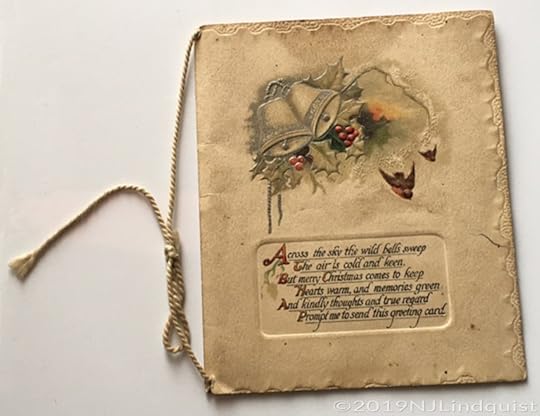
In case you have difficulty reading it, the verse says,
Across the sky the wild bells sweep,
The air is cold and keen,
But merry Christmas comes to keep
Hearts warm and memories green
And kindly thoughts and true regard
Prompt me to send this greeting card.
The writing on the back of the card is faint, but I was able to make out the words.
Publishers by appointment to their Majesties the King and Queen
Raphael Tuck & Sons Ltd London, Paris, Berlin, New York
Designed at the Studios in England and printed at the Fine Art Works in Bavaria
After a little research, I discovered that Raphael Tuck & Sons was a business started by Raphael Tuck and his wife in Bishopsgate in the City of London on October 1866. They sold pictures, greeting cards, and eventually postcards. Their business was very well-known in the late 1800s and early 1900s. Unfortunately, the building was bombed during the First World War.
Early on, they were named as "Publishers by Appointment " by Queen Victoria. Since my card mentions a King and Queen, it must date from between 1910, when King George V and Queen Mary took the throne, to the beginning of World War I, after which I assume they wouldn't have advertised and office in Berlin. Which makes the card at least 99 or 100 years old.
On the second page, it says,
"Best wishes for a Happy Christmas, from Minnie and Willie to Uncle George."
(George Shaw was my dad's father). I assume the card was sent by one of George's nephews who was named William, and who was married to a Mary; however, there were actually a number of Williams and several names that could have been shortened to Minnie in the Shaw family tree, so I'd need to do more research to be sure.
Anyway, the card most likely journeyed from Ireland to Rossburn, Manitoba.
And here is the verse that was inside. I think you can read it.
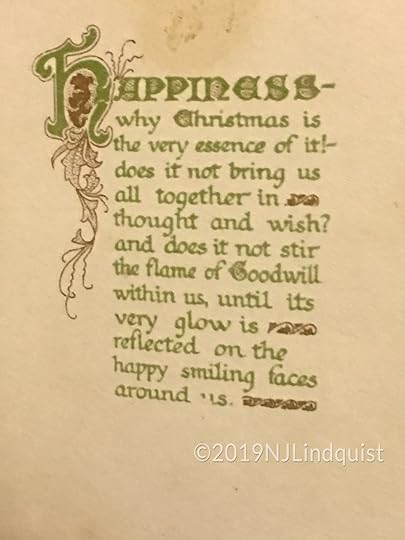
I wish you happiness this Christmas, too.
The post A 100-year-old Christmas greeting appeared first on N. J. Lindquist.



